Impact of Asian (Desi) Culture on Diabetes and Its Prevention
VerifiedAdded on 2024/05/17
|28
|4571
|119
AI Summary
This research paper explores the impact of Asian culture on diabetes prevalence and prevention. It examines the role of dietary habits, urbanization, modernization, and other cultural factors in contributing to the rising rates of diabetes in Asian countries. The study analyzes data from a questionnaire survey conducted among Asian individuals, highlighting the cultural influences on diabetes risk and exploring potential interventions for prevention and management.
Contribute Materials
Your contribution can guide someone’s learning journey. Share your
documents today.
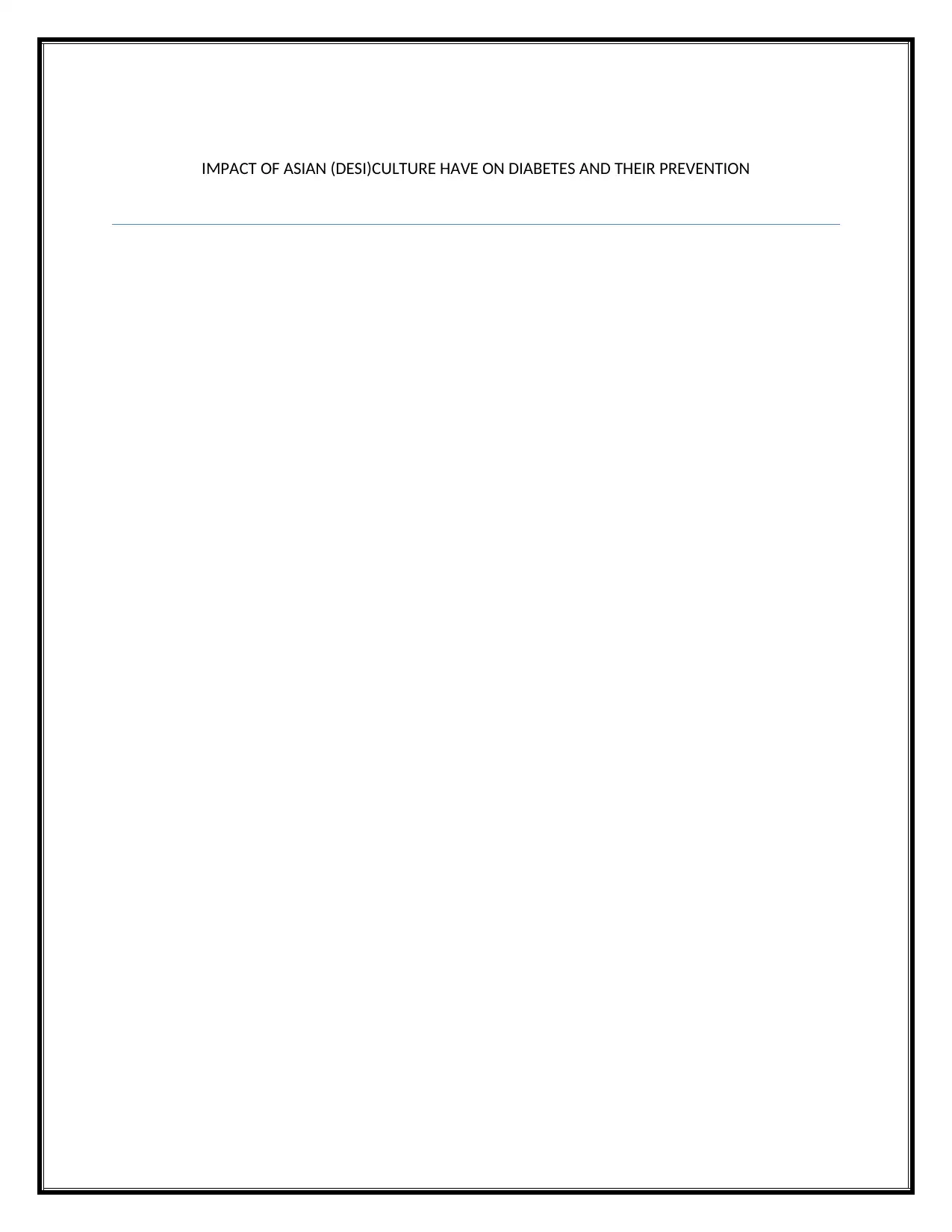
IMPACT OF ASIAN (DESI)CULTURE HAVE ON DIABETES AND THEIR PREVENTION
Secure Best Marks with AI Grader
Need help grading? Try our AI Grader for instant feedback on your assignments.
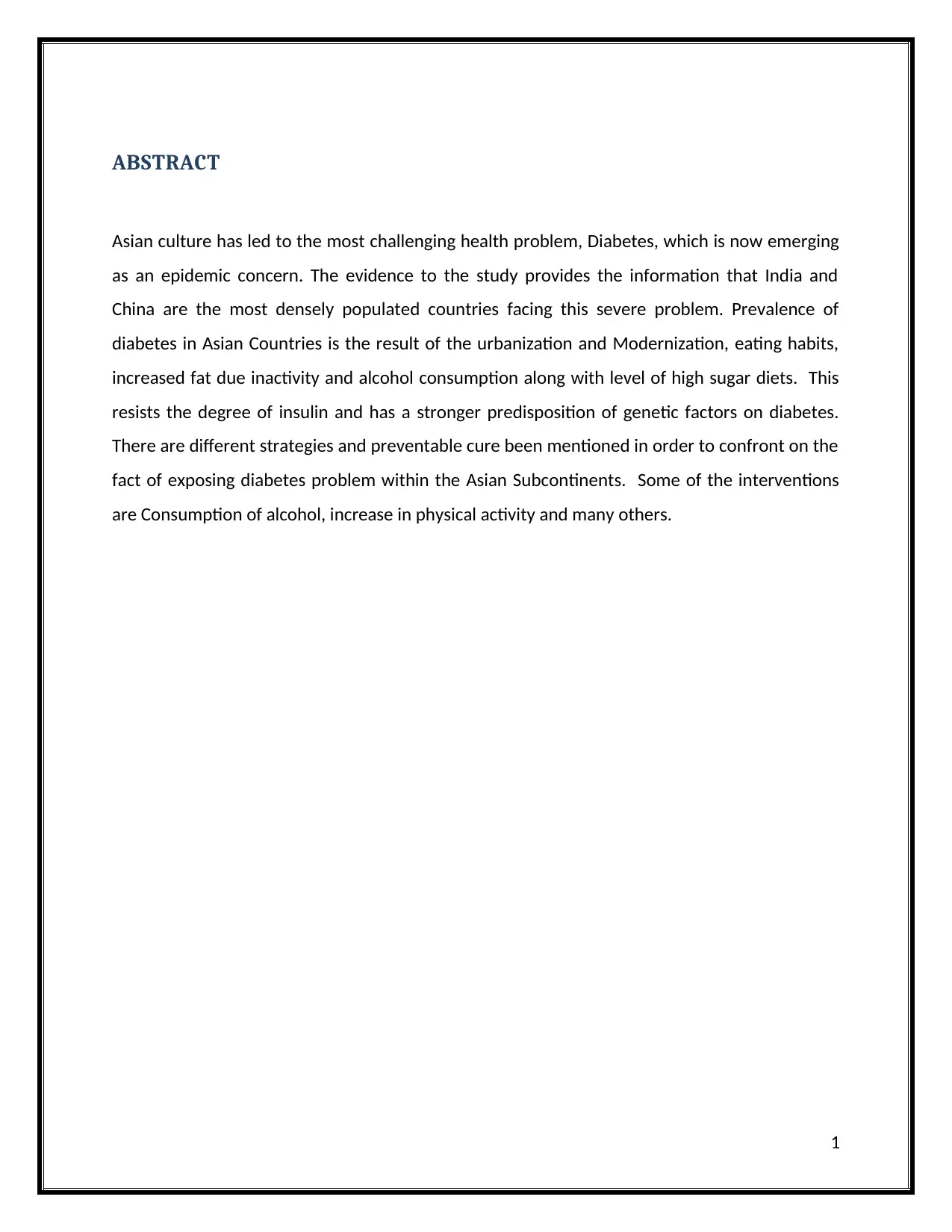
ABSTRACT
Asian culture has led to the most challenging health problem, Diabetes, which is now emerging
as an epidemic concern. The evidence to the study provides the information that India and
China are the most densely populated countries facing this severe problem. Prevalence of
diabetes in Asian Countries is the result of the urbanization and Modernization, eating habits,
increased fat due inactivity and alcohol consumption along with level of high sugar diets. This
resists the degree of insulin and has a stronger predisposition of genetic factors on diabetes.
There are different strategies and preventable cure been mentioned in order to confront on the
fact of exposing diabetes problem within the Asian Subcontinents. Some of the interventions
are Consumption of alcohol, increase in physical activity and many others.
1
Asian culture has led to the most challenging health problem, Diabetes, which is now emerging
as an epidemic concern. The evidence to the study provides the information that India and
China are the most densely populated countries facing this severe problem. Prevalence of
diabetes in Asian Countries is the result of the urbanization and Modernization, eating habits,
increased fat due inactivity and alcohol consumption along with level of high sugar diets. This
resists the degree of insulin and has a stronger predisposition of genetic factors on diabetes.
There are different strategies and preventable cure been mentioned in order to confront on the
fact of exposing diabetes problem within the Asian Subcontinents. Some of the interventions
are Consumption of alcohol, increase in physical activity and many others.
1
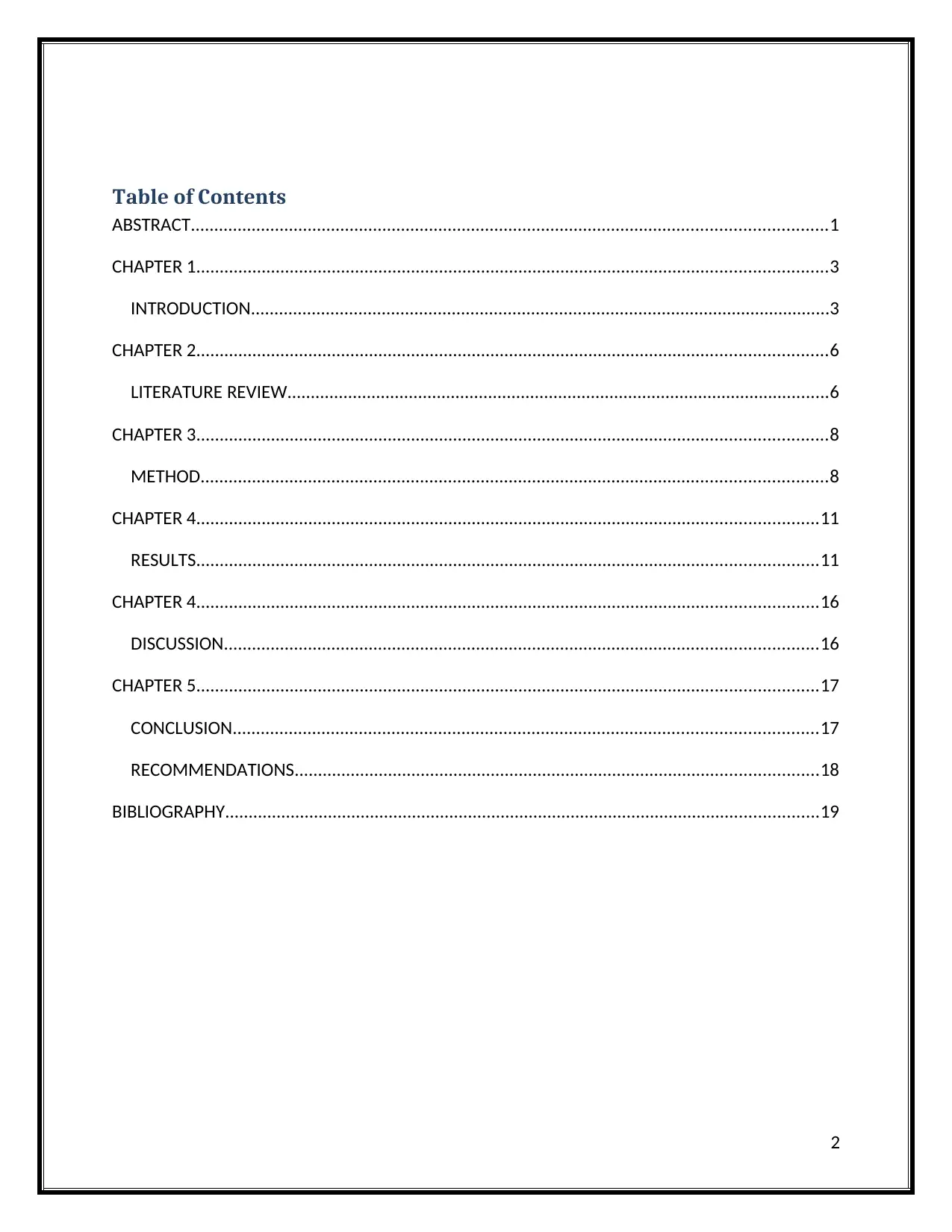
Table of Contents
ABSTRACT........................................................................................................................................1
CHAPTER 1.......................................................................................................................................3
INTRODUCTION............................................................................................................................3
CHAPTER 2.......................................................................................................................................6
LITERATURE REVIEW....................................................................................................................6
CHAPTER 3.......................................................................................................................................8
METHOD......................................................................................................................................8
CHAPTER 4.....................................................................................................................................11
RESULTS.....................................................................................................................................11
CHAPTER 4.....................................................................................................................................16
DISCUSSION...............................................................................................................................16
CHAPTER 5.....................................................................................................................................17
CONCLUSION.............................................................................................................................17
RECOMMENDATIONS................................................................................................................18
BIBLIOGRAPHY...............................................................................................................................19
2
ABSTRACT........................................................................................................................................1
CHAPTER 1.......................................................................................................................................3
INTRODUCTION............................................................................................................................3
CHAPTER 2.......................................................................................................................................6
LITERATURE REVIEW....................................................................................................................6
CHAPTER 3.......................................................................................................................................8
METHOD......................................................................................................................................8
CHAPTER 4.....................................................................................................................................11
RESULTS.....................................................................................................................................11
CHAPTER 4.....................................................................................................................................16
DISCUSSION...............................................................................................................................16
CHAPTER 5.....................................................................................................................................17
CONCLUSION.............................................................................................................................17
RECOMMENDATIONS................................................................................................................18
BIBLIOGRAPHY...............................................................................................................................19
2
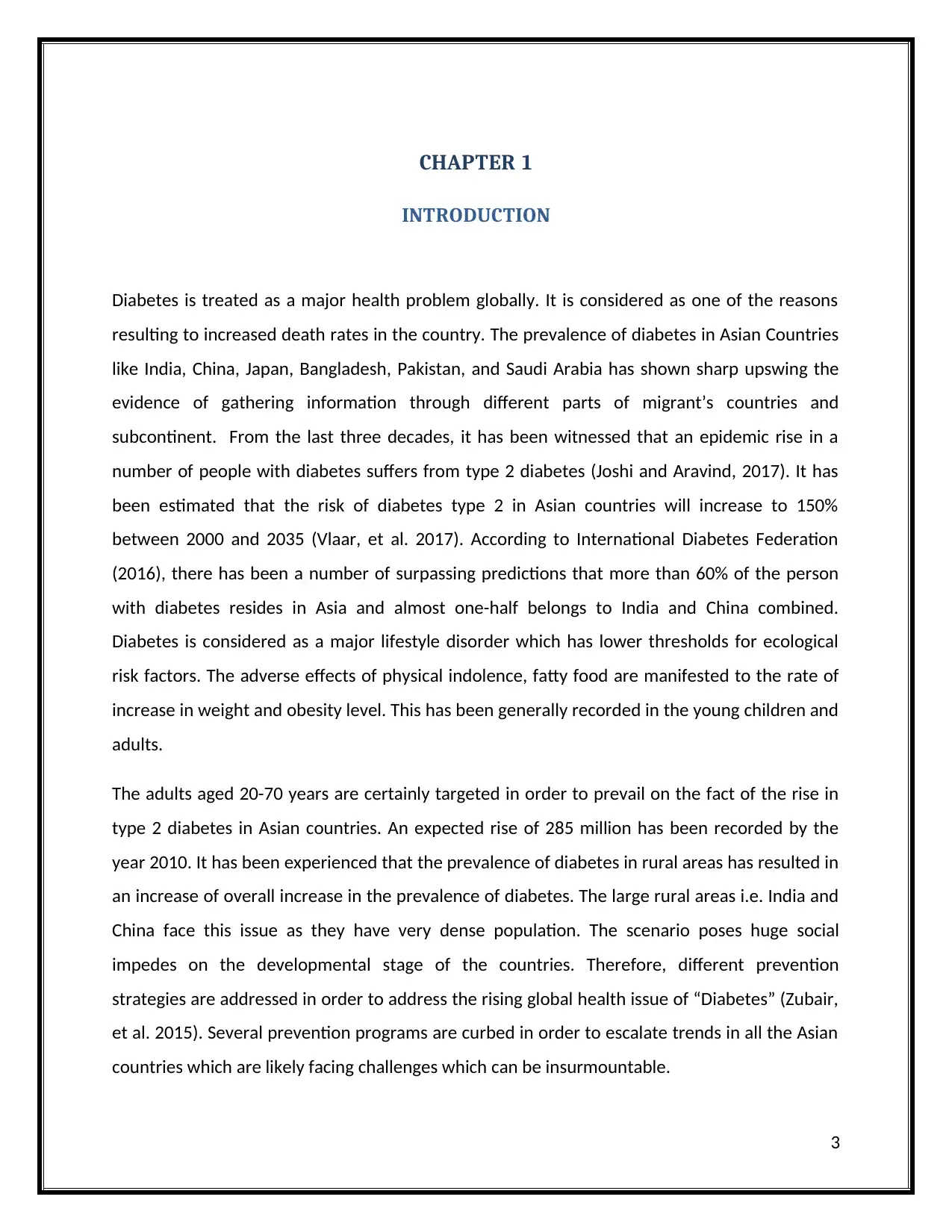
CHAPTER 1
INTRODUCTION
Diabetes is treated as a major health problem globally. It is considered as one of the reasons
resulting to increased death rates in the country. The prevalence of diabetes in Asian Countries
like India, China, Japan, Bangladesh, Pakistan, and Saudi Arabia has shown sharp upswing the
evidence of gathering information through different parts of migrant’s countries and
subcontinent. From the last three decades, it has been witnessed that an epidemic rise in a
number of people with diabetes suffers from type 2 diabetes (Joshi and Aravind, 2017). It has
been estimated that the risk of diabetes type 2 in Asian countries will increase to 150%
between 2000 and 2035 (Vlaar, et al. 2017). According to International Diabetes Federation
(2016), there has been a number of surpassing predictions that more than 60% of the person
with diabetes resides in Asia and almost one-half belongs to India and China combined.
Diabetes is considered as a major lifestyle disorder which has lower thresholds for ecological
risk factors. The adverse effects of physical indolence, fatty food are manifested to the rate of
increase in weight and obesity level. This has been generally recorded in the young children and
adults.
The adults aged 20-70 years are certainly targeted in order to prevail on the fact of the rise in
type 2 diabetes in Asian countries. An expected rise of 285 million has been recorded by the
year 2010. It has been experienced that the prevalence of diabetes in rural areas has resulted in
an increase of overall increase in the prevalence of diabetes. The large rural areas i.e. India and
China face this issue as they have very dense population. The scenario poses huge social
impedes on the developmental stage of the countries. Therefore, different prevention
strategies are addressed in order to address the rising global health issue of “Diabetes” (Zubair,
et al. 2015). Several prevention programs are curbed in order to escalate trends in all the Asian
countries which are likely facing challenges which can be insurmountable.
3
INTRODUCTION
Diabetes is treated as a major health problem globally. It is considered as one of the reasons
resulting to increased death rates in the country. The prevalence of diabetes in Asian Countries
like India, China, Japan, Bangladesh, Pakistan, and Saudi Arabia has shown sharp upswing the
evidence of gathering information through different parts of migrant’s countries and
subcontinent. From the last three decades, it has been witnessed that an epidemic rise in a
number of people with diabetes suffers from type 2 diabetes (Joshi and Aravind, 2017). It has
been estimated that the risk of diabetes type 2 in Asian countries will increase to 150%
between 2000 and 2035 (Vlaar, et al. 2017). According to International Diabetes Federation
(2016), there has been a number of surpassing predictions that more than 60% of the person
with diabetes resides in Asia and almost one-half belongs to India and China combined.
Diabetes is considered as a major lifestyle disorder which has lower thresholds for ecological
risk factors. The adverse effects of physical indolence, fatty food are manifested to the rate of
increase in weight and obesity level. This has been generally recorded in the young children and
adults.
The adults aged 20-70 years are certainly targeted in order to prevail on the fact of the rise in
type 2 diabetes in Asian countries. An expected rise of 285 million has been recorded by the
year 2010. It has been experienced that the prevalence of diabetes in rural areas has resulted in
an increase of overall increase in the prevalence of diabetes. The large rural areas i.e. India and
China face this issue as they have very dense population. The scenario poses huge social
impedes on the developmental stage of the countries. Therefore, different prevention
strategies are addressed in order to address the rising global health issue of “Diabetes” (Zubair,
et al. 2015). Several prevention programs are curbed in order to escalate trends in all the Asian
countries which are likely facing challenges which can be insurmountable.
3
Paraphrase This Document
Need a fresh take? Get an instant paraphrase of this document with our AI Paraphraser
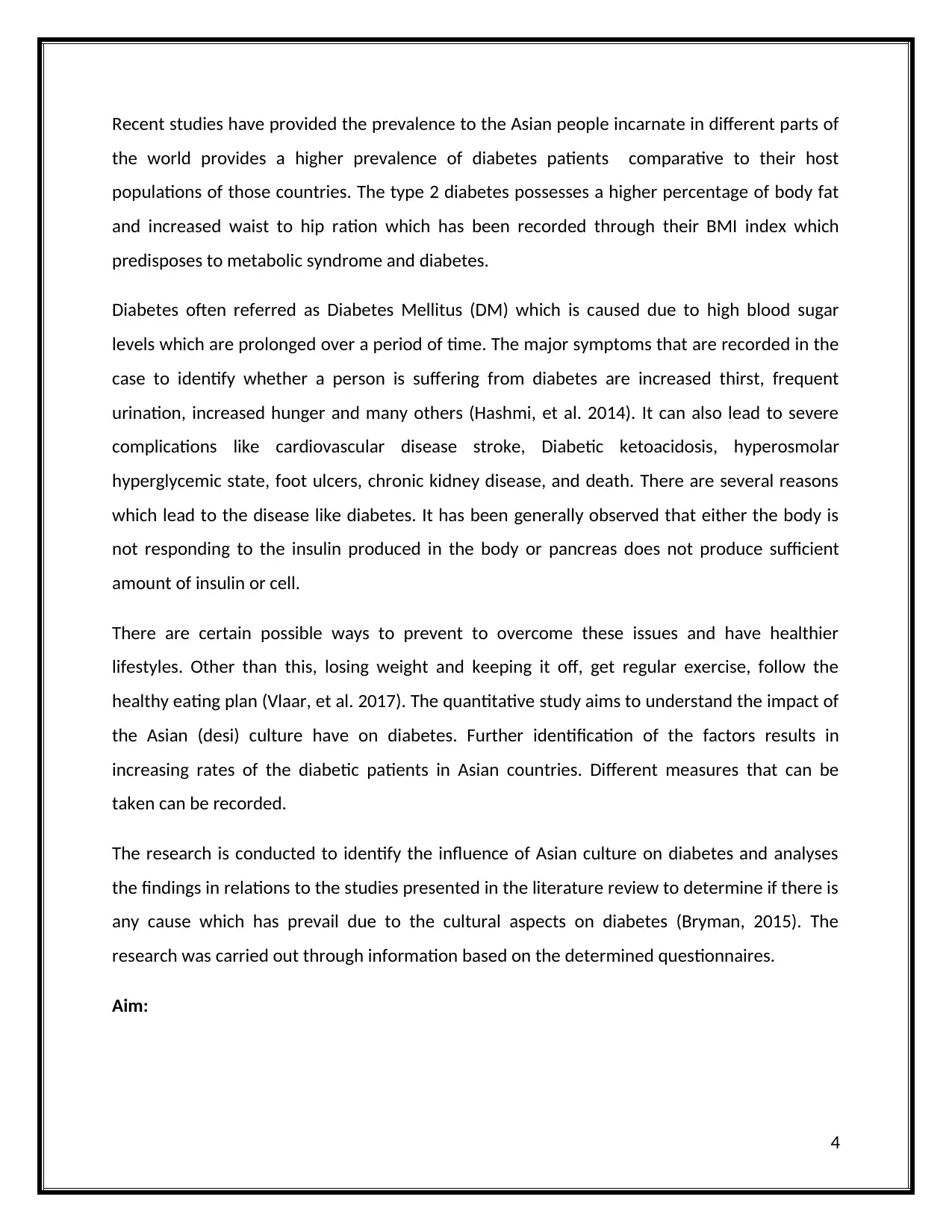
Recent studies have provided the prevalence to the Asian people incarnate in different parts of
the world provides a higher prevalence of diabetes patients comparative to their host
populations of those countries. The type 2 diabetes possesses a higher percentage of body fat
and increased waist to hip ration which has been recorded through their BMI index which
predisposes to metabolic syndrome and diabetes.
Diabetes often referred as Diabetes Mellitus (DM) which is caused due to high blood sugar
levels which are prolonged over a period of time. The major symptoms that are recorded in the
case to identify whether a person is suffering from diabetes are increased thirst, frequent
urination, increased hunger and many others (Hashmi, et al. 2014). It can also lead to severe
complications like cardiovascular disease stroke, Diabetic ketoacidosis, hyperosmolar
hyperglycemic state, foot ulcers, chronic kidney disease, and death. There are several reasons
which lead to the disease like diabetes. It has been generally observed that either the body is
not responding to the insulin produced in the body or pancreas does not produce sufficient
amount of insulin or cell.
There are certain possible ways to prevent to overcome these issues and have healthier
lifestyles. Other than this, losing weight and keeping it off, get regular exercise, follow the
healthy eating plan (Vlaar, et al. 2017). The quantitative study aims to understand the impact of
the Asian (desi) culture have on diabetes. Further identification of the factors results in
increasing rates of the diabetic patients in Asian countries. Different measures that can be
taken can be recorded.
The research is conducted to identify the influence of Asian culture on diabetes and analyses
the findings in relations to the studies presented in the literature review to determine if there is
any cause which has prevail due to the cultural aspects on diabetes (Bryman, 2015). The
research was carried out through information based on the determined questionnaires.
Aim:
4
the world provides a higher prevalence of diabetes patients comparative to their host
populations of those countries. The type 2 diabetes possesses a higher percentage of body fat
and increased waist to hip ration which has been recorded through their BMI index which
predisposes to metabolic syndrome and diabetes.
Diabetes often referred as Diabetes Mellitus (DM) which is caused due to high blood sugar
levels which are prolonged over a period of time. The major symptoms that are recorded in the
case to identify whether a person is suffering from diabetes are increased thirst, frequent
urination, increased hunger and many others (Hashmi, et al. 2014). It can also lead to severe
complications like cardiovascular disease stroke, Diabetic ketoacidosis, hyperosmolar
hyperglycemic state, foot ulcers, chronic kidney disease, and death. There are several reasons
which lead to the disease like diabetes. It has been generally observed that either the body is
not responding to the insulin produced in the body or pancreas does not produce sufficient
amount of insulin or cell.
There are certain possible ways to prevent to overcome these issues and have healthier
lifestyles. Other than this, losing weight and keeping it off, get regular exercise, follow the
healthy eating plan (Vlaar, et al. 2017). The quantitative study aims to understand the impact of
the Asian (desi) culture have on diabetes. Further identification of the factors results in
increasing rates of the diabetic patients in Asian countries. Different measures that can be
taken can be recorded.
The research is conducted to identify the influence of Asian culture on diabetes and analyses
the findings in relations to the studies presented in the literature review to determine if there is
any cause which has prevail due to the cultural aspects on diabetes (Bryman, 2015). The
research was carried out through information based on the determined questionnaires.
Aim:
4
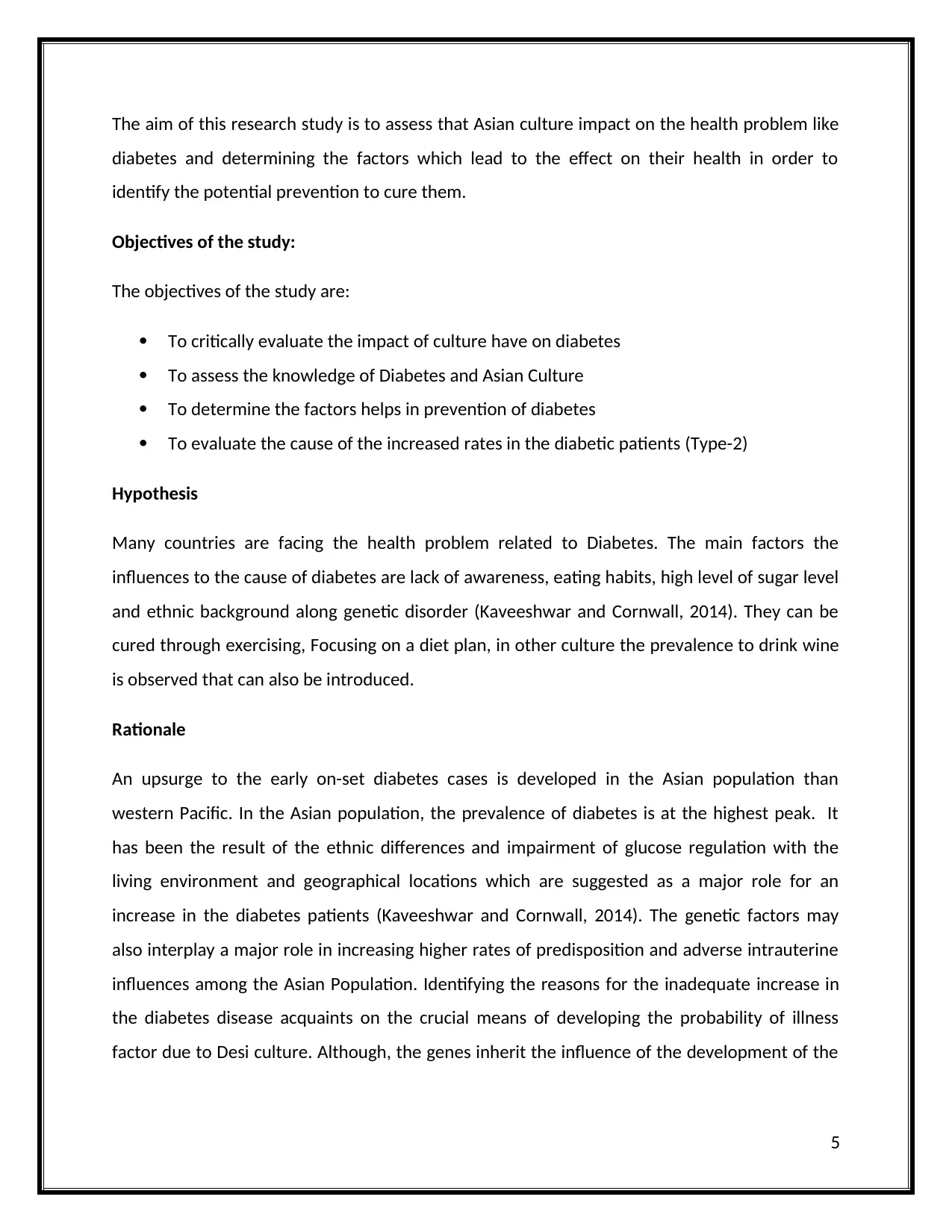
The aim of this research study is to assess that Asian culture impact on the health problem like
diabetes and determining the factors which lead to the effect on their health in order to
identify the potential prevention to cure them.
Objectives of the study:
The objectives of the study are:
To critically evaluate the impact of culture have on diabetes
To assess the knowledge of Diabetes and Asian Culture
To determine the factors helps in prevention of diabetes
To evaluate the cause of the increased rates in the diabetic patients (Type-2)
Hypothesis
Many countries are facing the health problem related to Diabetes. The main factors the
influences to the cause of diabetes are lack of awareness, eating habits, high level of sugar level
and ethnic background along genetic disorder (Kaveeshwar and Cornwall, 2014). They can be
cured through exercising, Focusing on a diet plan, in other culture the prevalence to drink wine
is observed that can also be introduced.
Rationale
An upsurge to the early on-set diabetes cases is developed in the Asian population than
western Pacific. In the Asian population, the prevalence of diabetes is at the highest peak. It
has been the result of the ethnic differences and impairment of glucose regulation with the
living environment and geographical locations which are suggested as a major role for an
increase in the diabetes patients (Kaveeshwar and Cornwall, 2014). The genetic factors may
also interplay a major role in increasing higher rates of predisposition and adverse intrauterine
influences among the Asian Population. Identifying the reasons for the inadequate increase in
the diabetes disease acquaints on the crucial means of developing the probability of illness
factor due to Desi culture. Although, the genes inherit the influence of the development of the
5
diabetes and determining the factors which lead to the effect on their health in order to
identify the potential prevention to cure them.
Objectives of the study:
The objectives of the study are:
To critically evaluate the impact of culture have on diabetes
To assess the knowledge of Diabetes and Asian Culture
To determine the factors helps in prevention of diabetes
To evaluate the cause of the increased rates in the diabetic patients (Type-2)
Hypothesis
Many countries are facing the health problem related to Diabetes. The main factors the
influences to the cause of diabetes are lack of awareness, eating habits, high level of sugar level
and ethnic background along genetic disorder (Kaveeshwar and Cornwall, 2014). They can be
cured through exercising, Focusing on a diet plan, in other culture the prevalence to drink wine
is observed that can also be introduced.
Rationale
An upsurge to the early on-set diabetes cases is developed in the Asian population than
western Pacific. In the Asian population, the prevalence of diabetes is at the highest peak. It
has been the result of the ethnic differences and impairment of glucose regulation with the
living environment and geographical locations which are suggested as a major role for an
increase in the diabetes patients (Kaveeshwar and Cornwall, 2014). The genetic factors may
also interplay a major role in increasing higher rates of predisposition and adverse intrauterine
influences among the Asian Population. Identifying the reasons for the inadequate increase in
the diabetes disease acquaints on the crucial means of developing the probability of illness
factor due to Desi culture. Although, the genes inherit the influence of the development of the
5
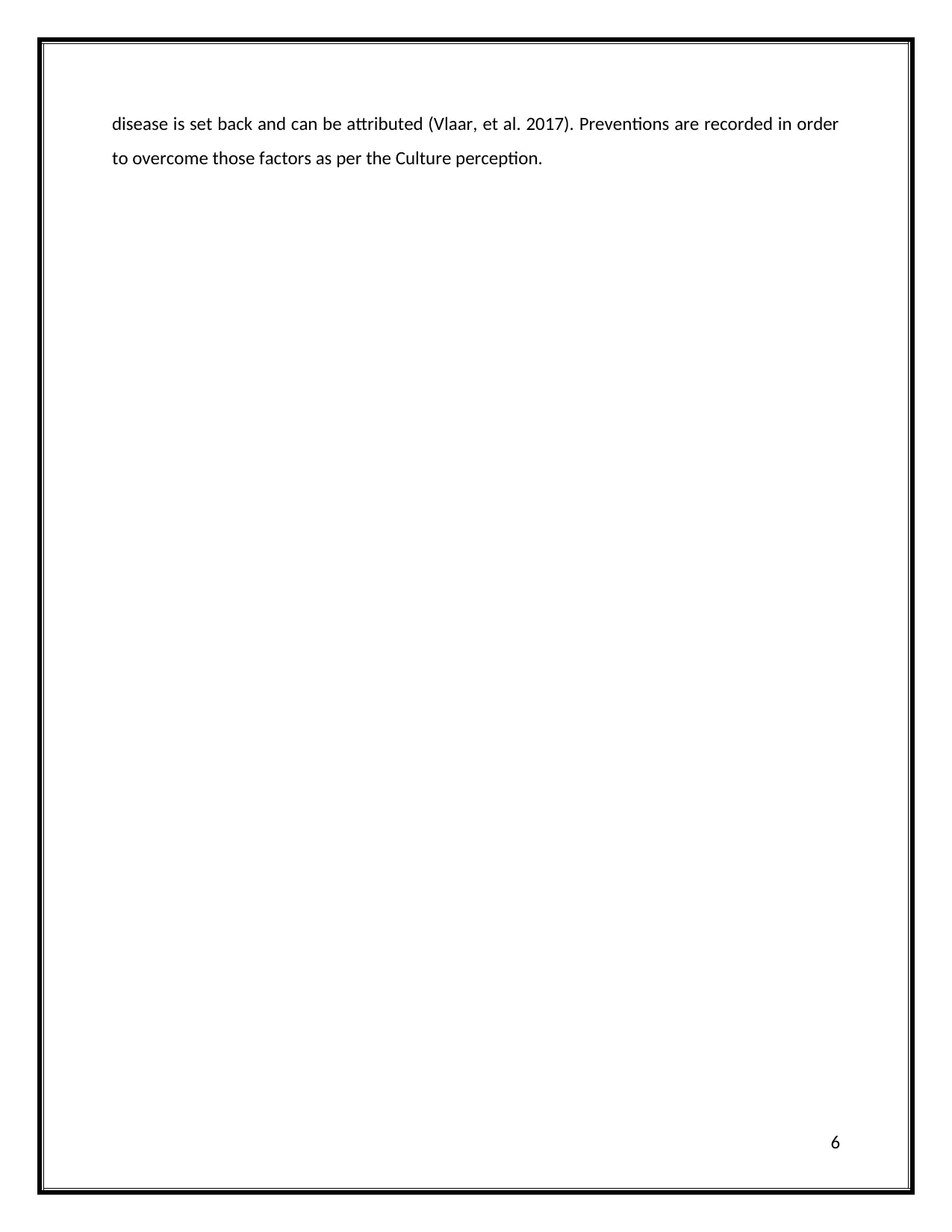
disease is set back and can be attributed (Vlaar, et al. 2017). Preventions are recorded in order
to overcome those factors as per the Culture perception.
6
to overcome those factors as per the Culture perception.
6
Secure Best Marks with AI Grader
Need help grading? Try our AI Grader for instant feedback on your assignments.
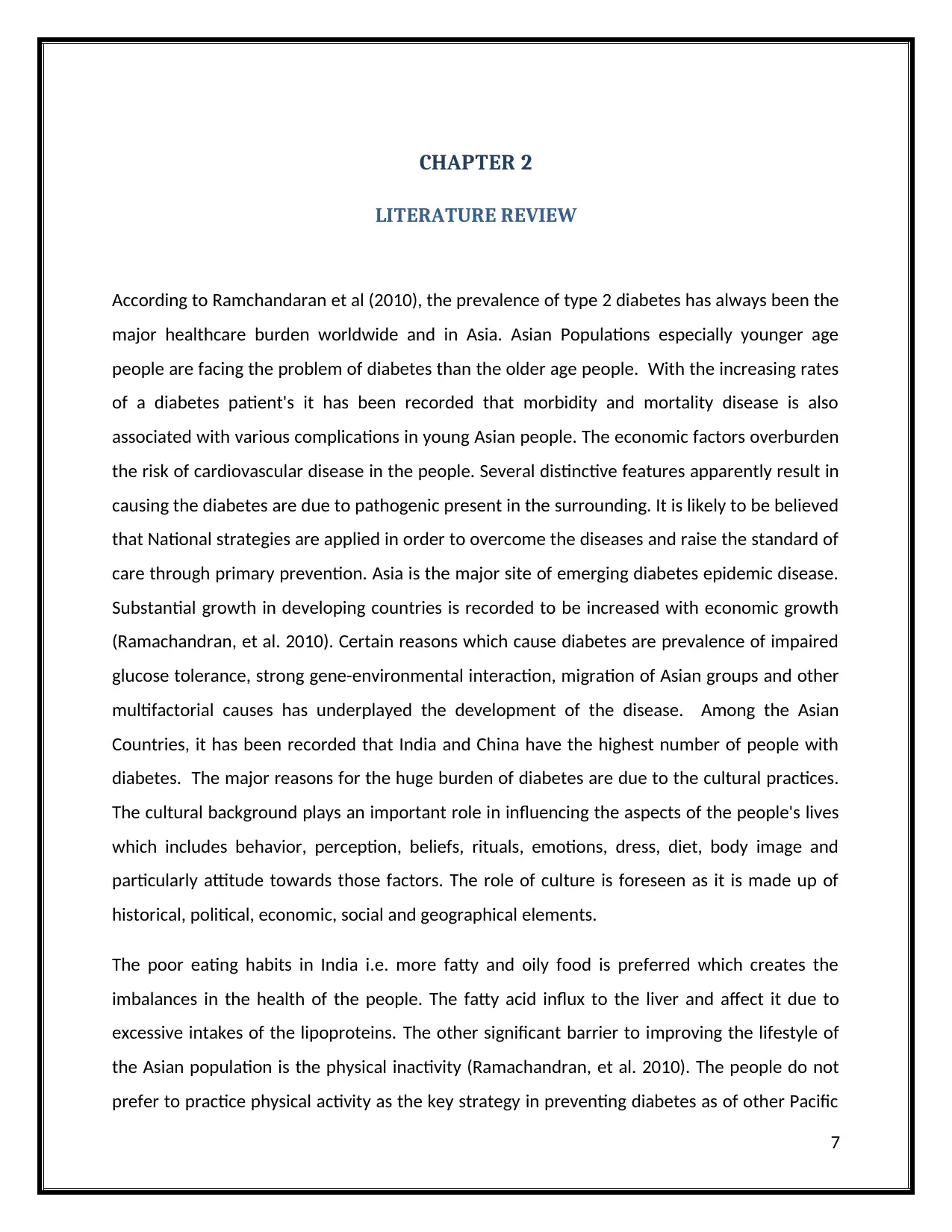
CHAPTER 2
LITERATURE REVIEW
According to Ramchandaran et al (2010), the prevalence of type 2 diabetes has always been the
major healthcare burden worldwide and in Asia. Asian Populations especially younger age
people are facing the problem of diabetes than the older age people. With the increasing rates
of a diabetes patient's it has been recorded that morbidity and mortality disease is also
associated with various complications in young Asian people. The economic factors overburden
the risk of cardiovascular disease in the people. Several distinctive features apparently result in
causing the diabetes are due to pathogenic present in the surrounding. It is likely to be believed
that National strategies are applied in order to overcome the diseases and raise the standard of
care through primary prevention. Asia is the major site of emerging diabetes epidemic disease.
Substantial growth in developing countries is recorded to be increased with economic growth
(Ramachandran, et al. 2010). Certain reasons which cause diabetes are prevalence of impaired
glucose tolerance, strong gene-environmental interaction, migration of Asian groups and other
multifactorial causes has underplayed the development of the disease. Among the Asian
Countries, it has been recorded that India and China have the highest number of people with
diabetes. The major reasons for the huge burden of diabetes are due to the cultural practices.
The cultural background plays an important role in influencing the aspects of the people's lives
which includes behavior, perception, beliefs, rituals, emotions, dress, diet, body image and
particularly attitude towards those factors. The role of culture is foreseen as it is made up of
historical, political, economic, social and geographical elements.
The poor eating habits in India i.e. more fatty and oily food is preferred which creates the
imbalances in the health of the people. The fatty acid influx to the liver and affect it due to
excessive intakes of the lipoproteins. The other significant barrier to improving the lifestyle of
the Asian population is the physical inactivity (Ramachandran, et al. 2010). The people do not
prefer to practice physical activity as the key strategy in preventing diabetes as of other Pacific
7
LITERATURE REVIEW
According to Ramchandaran et al (2010), the prevalence of type 2 diabetes has always been the
major healthcare burden worldwide and in Asia. Asian Populations especially younger age
people are facing the problem of diabetes than the older age people. With the increasing rates
of a diabetes patient's it has been recorded that morbidity and mortality disease is also
associated with various complications in young Asian people. The economic factors overburden
the risk of cardiovascular disease in the people. Several distinctive features apparently result in
causing the diabetes are due to pathogenic present in the surrounding. It is likely to be believed
that National strategies are applied in order to overcome the diseases and raise the standard of
care through primary prevention. Asia is the major site of emerging diabetes epidemic disease.
Substantial growth in developing countries is recorded to be increased with economic growth
(Ramachandran, et al. 2010). Certain reasons which cause diabetes are prevalence of impaired
glucose tolerance, strong gene-environmental interaction, migration of Asian groups and other
multifactorial causes has underplayed the development of the disease. Among the Asian
Countries, it has been recorded that India and China have the highest number of people with
diabetes. The major reasons for the huge burden of diabetes are due to the cultural practices.
The cultural background plays an important role in influencing the aspects of the people's lives
which includes behavior, perception, beliefs, rituals, emotions, dress, diet, body image and
particularly attitude towards those factors. The role of culture is foreseen as it is made up of
historical, political, economic, social and geographical elements.
The poor eating habits in India i.e. more fatty and oily food is preferred which creates the
imbalances in the health of the people. The fatty acid influx to the liver and affect it due to
excessive intakes of the lipoproteins. The other significant barrier to improving the lifestyle of
the Asian population is the physical inactivity (Ramachandran, et al. 2010). The people do not
prefer to practice physical activity as the key strategy in preventing diabetes as of other Pacific
7
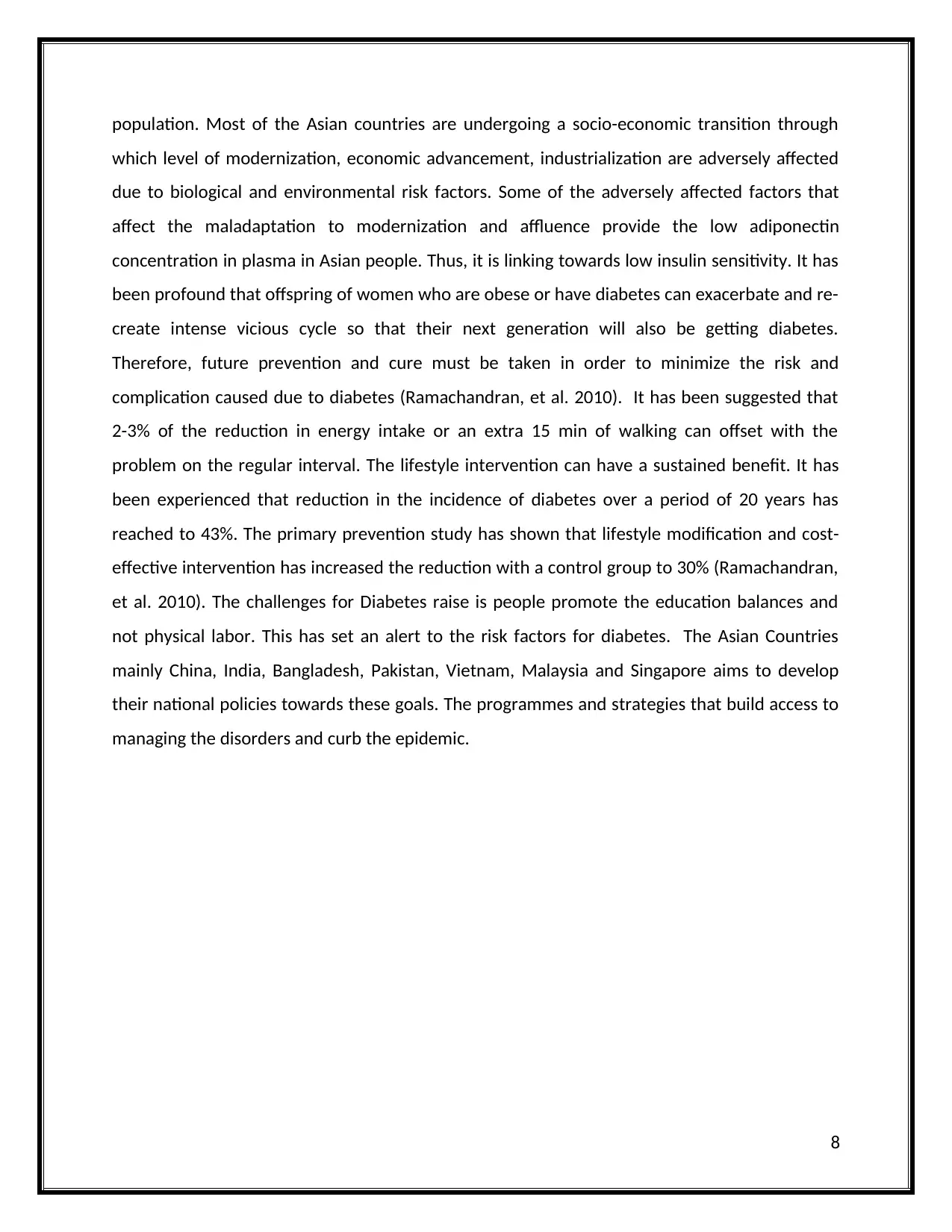
population. Most of the Asian countries are undergoing a socio-economic transition through
which level of modernization, economic advancement, industrialization are adversely affected
due to biological and environmental risk factors. Some of the adversely affected factors that
affect the maladaptation to modernization and affluence provide the low adiponectin
concentration in plasma in Asian people. Thus, it is linking towards low insulin sensitivity. It has
been profound that offspring of women who are obese or have diabetes can exacerbate and re-
create intense vicious cycle so that their next generation will also be getting diabetes.
Therefore, future prevention and cure must be taken in order to minimize the risk and
complication caused due to diabetes (Ramachandran, et al. 2010). It has been suggested that
2-3% of the reduction in energy intake or an extra 15 min of walking can offset with the
problem on the regular interval. The lifestyle intervention can have a sustained benefit. It has
been experienced that reduction in the incidence of diabetes over a period of 20 years has
reached to 43%. The primary prevention study has shown that lifestyle modification and cost-
effective intervention has increased the reduction with a control group to 30% (Ramachandran,
et al. 2010). The challenges for Diabetes raise is people promote the education balances and
not physical labor. This has set an alert to the risk factors for diabetes. The Asian Countries
mainly China, India, Bangladesh, Pakistan, Vietnam, Malaysia and Singapore aims to develop
their national policies towards these goals. The programmes and strategies that build access to
managing the disorders and curb the epidemic.
8
which level of modernization, economic advancement, industrialization are adversely affected
due to biological and environmental risk factors. Some of the adversely affected factors that
affect the maladaptation to modernization and affluence provide the low adiponectin
concentration in plasma in Asian people. Thus, it is linking towards low insulin sensitivity. It has
been profound that offspring of women who are obese or have diabetes can exacerbate and re-
create intense vicious cycle so that their next generation will also be getting diabetes.
Therefore, future prevention and cure must be taken in order to minimize the risk and
complication caused due to diabetes (Ramachandran, et al. 2010). It has been suggested that
2-3% of the reduction in energy intake or an extra 15 min of walking can offset with the
problem on the regular interval. The lifestyle intervention can have a sustained benefit. It has
been experienced that reduction in the incidence of diabetes over a period of 20 years has
reached to 43%. The primary prevention study has shown that lifestyle modification and cost-
effective intervention has increased the reduction with a control group to 30% (Ramachandran,
et al. 2010). The challenges for Diabetes raise is people promote the education balances and
not physical labor. This has set an alert to the risk factors for diabetes. The Asian Countries
mainly China, India, Bangladesh, Pakistan, Vietnam, Malaysia and Singapore aims to develop
their national policies towards these goals. The programmes and strategies that build access to
managing the disorders and curb the epidemic.
8
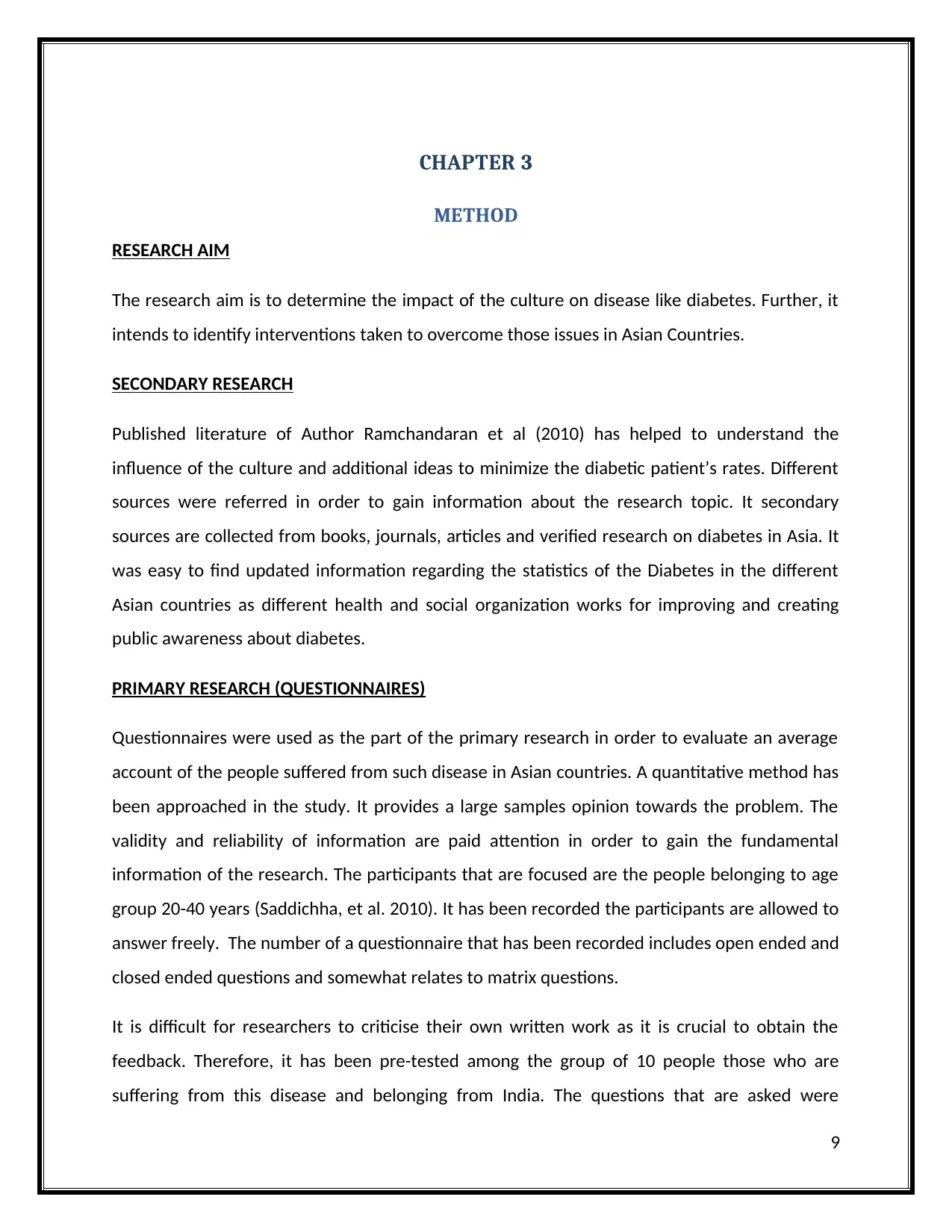
CHAPTER 3
METHOD
RESEARCH AIM
The research aim is to determine the impact of the culture on disease like diabetes. Further, it
intends to identify interventions taken to overcome those issues in Asian Countries.
SECONDARY RESEARCH
Published literature of Author Ramchandaran et al (2010) has helped to understand the
influence of the culture and additional ideas to minimize the diabetic patient’s rates. Different
sources were referred in order to gain information about the research topic. It secondary
sources are collected from books, journals, articles and verified research on diabetes in Asia. It
was easy to find updated information regarding the statistics of the Diabetes in the different
Asian countries as different health and social organization works for improving and creating
public awareness about diabetes.
PRIMARY RESEARCH (QUESTIONNAIRES)
Questionnaires were used as the part of the primary research in order to evaluate an average
account of the people suffered from such disease in Asian countries. A quantitative method has
been approached in the study. It provides a large samples opinion towards the problem. The
validity and reliability of information are paid attention in order to gain the fundamental
information of the research. The participants that are focused are the people belonging to age
group 20-40 years (Saddichha, et al. 2010). It has been recorded the participants are allowed to
answer freely. The number of a questionnaire that has been recorded includes open ended and
closed ended questions and somewhat relates to matrix questions.
It is difficult for researchers to criticise their own written work as it is crucial to obtain the
feedback. Therefore, it has been pre-tested among the group of 10 people those who are
suffering from this disease and belonging from India. The questions that are asked were
9
METHOD
RESEARCH AIM
The research aim is to determine the impact of the culture on disease like diabetes. Further, it
intends to identify interventions taken to overcome those issues in Asian Countries.
SECONDARY RESEARCH
Published literature of Author Ramchandaran et al (2010) has helped to understand the
influence of the culture and additional ideas to minimize the diabetic patient’s rates. Different
sources were referred in order to gain information about the research topic. It secondary
sources are collected from books, journals, articles and verified research on diabetes in Asia. It
was easy to find updated information regarding the statistics of the Diabetes in the different
Asian countries as different health and social organization works for improving and creating
public awareness about diabetes.
PRIMARY RESEARCH (QUESTIONNAIRES)
Questionnaires were used as the part of the primary research in order to evaluate an average
account of the people suffered from such disease in Asian countries. A quantitative method has
been approached in the study. It provides a large samples opinion towards the problem. The
validity and reliability of information are paid attention in order to gain the fundamental
information of the research. The participants that are focused are the people belonging to age
group 20-40 years (Saddichha, et al. 2010). It has been recorded the participants are allowed to
answer freely. The number of a questionnaire that has been recorded includes open ended and
closed ended questions and somewhat relates to matrix questions.
It is difficult for researchers to criticise their own written work as it is crucial to obtain the
feedback. Therefore, it has been pre-tested among the group of 10 people those who are
suffering from this disease and belonging from India. The questions that are asked were
9
Paraphrase This Document
Need a fresh take? Get an instant paraphrase of this document with our AI Paraphraser
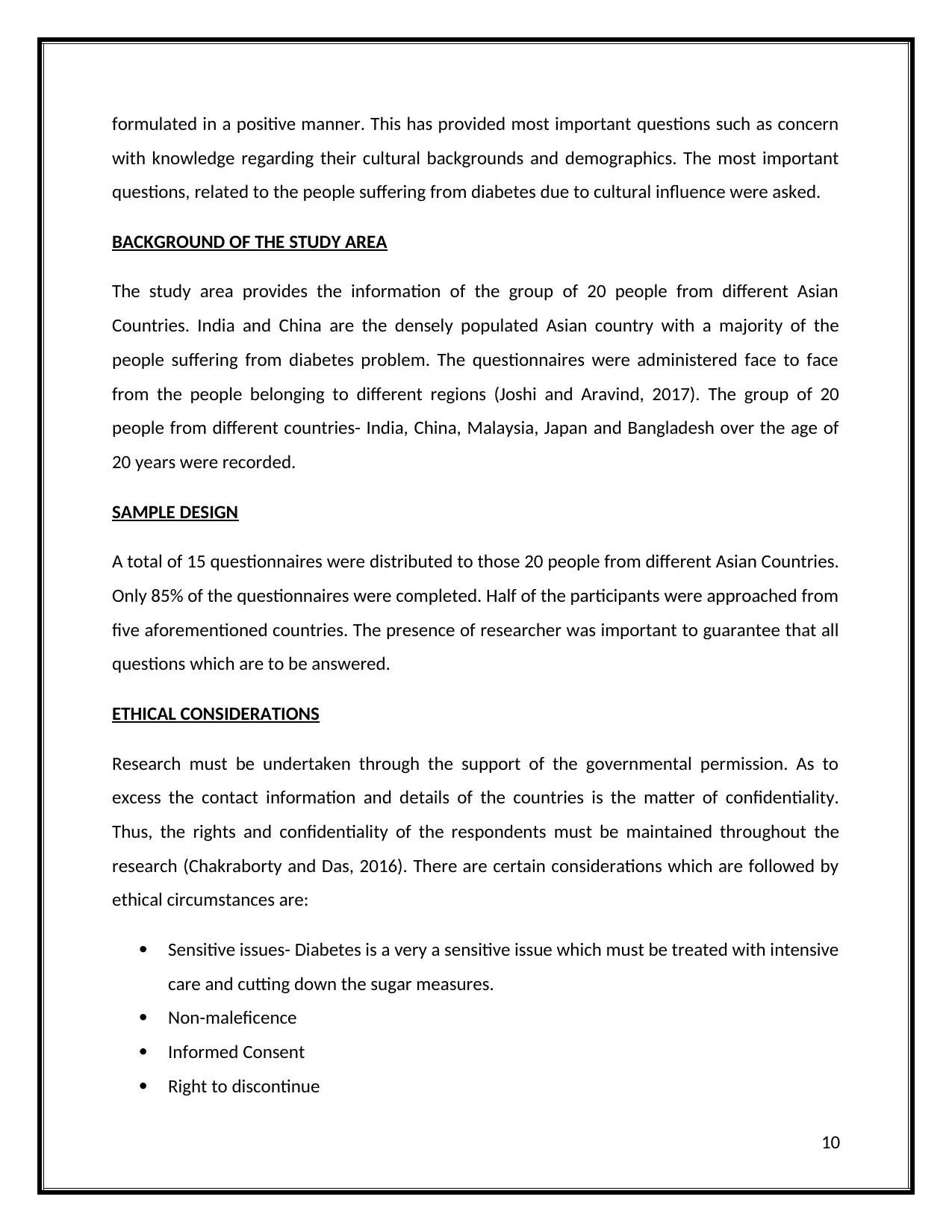
formulated in a positive manner. This has provided most important questions such as concern
with knowledge regarding their cultural backgrounds and demographics. The most important
questions, related to the people suffering from diabetes due to cultural influence were asked.
BACKGROUND OF THE STUDY AREA
The study area provides the information of the group of 20 people from different Asian
Countries. India and China are the densely populated Asian country with a majority of the
people suffering from diabetes problem. The questionnaires were administered face to face
from the people belonging to different regions (Joshi and Aravind, 2017). The group of 20
people from different countries- India, China, Malaysia, Japan and Bangladesh over the age of
20 years were recorded.
SAMPLE DESIGN
A total of 15 questionnaires were distributed to those 20 people from different Asian Countries.
Only 85% of the questionnaires were completed. Half of the participants were approached from
five aforementioned countries. The presence of researcher was important to guarantee that all
questions which are to be answered.
ETHICAL CONSIDERATIONS
Research must be undertaken through the support of the governmental permission. As to
excess the contact information and details of the countries is the matter of confidentiality.
Thus, the rights and confidentiality of the respondents must be maintained throughout the
research (Chakraborty and Das, 2016). There are certain considerations which are followed by
ethical circumstances are:
Sensitive issues- Diabetes is a very a sensitive issue which must be treated with intensive
care and cutting down the sugar measures.
Non-maleficence
Informed Consent
Right to discontinue
10
with knowledge regarding their cultural backgrounds and demographics. The most important
questions, related to the people suffering from diabetes due to cultural influence were asked.
BACKGROUND OF THE STUDY AREA
The study area provides the information of the group of 20 people from different Asian
Countries. India and China are the densely populated Asian country with a majority of the
people suffering from diabetes problem. The questionnaires were administered face to face
from the people belonging to different regions (Joshi and Aravind, 2017). The group of 20
people from different countries- India, China, Malaysia, Japan and Bangladesh over the age of
20 years were recorded.
SAMPLE DESIGN
A total of 15 questionnaires were distributed to those 20 people from different Asian Countries.
Only 85% of the questionnaires were completed. Half of the participants were approached from
five aforementioned countries. The presence of researcher was important to guarantee that all
questions which are to be answered.
ETHICAL CONSIDERATIONS
Research must be undertaken through the support of the governmental permission. As to
excess the contact information and details of the countries is the matter of confidentiality.
Thus, the rights and confidentiality of the respondents must be maintained throughout the
research (Chakraborty and Das, 2016). There are certain considerations which are followed by
ethical circumstances are:
Sensitive issues- Diabetes is a very a sensitive issue which must be treated with intensive
care and cutting down the sugar measures.
Non-maleficence
Informed Consent
Right to discontinue
10
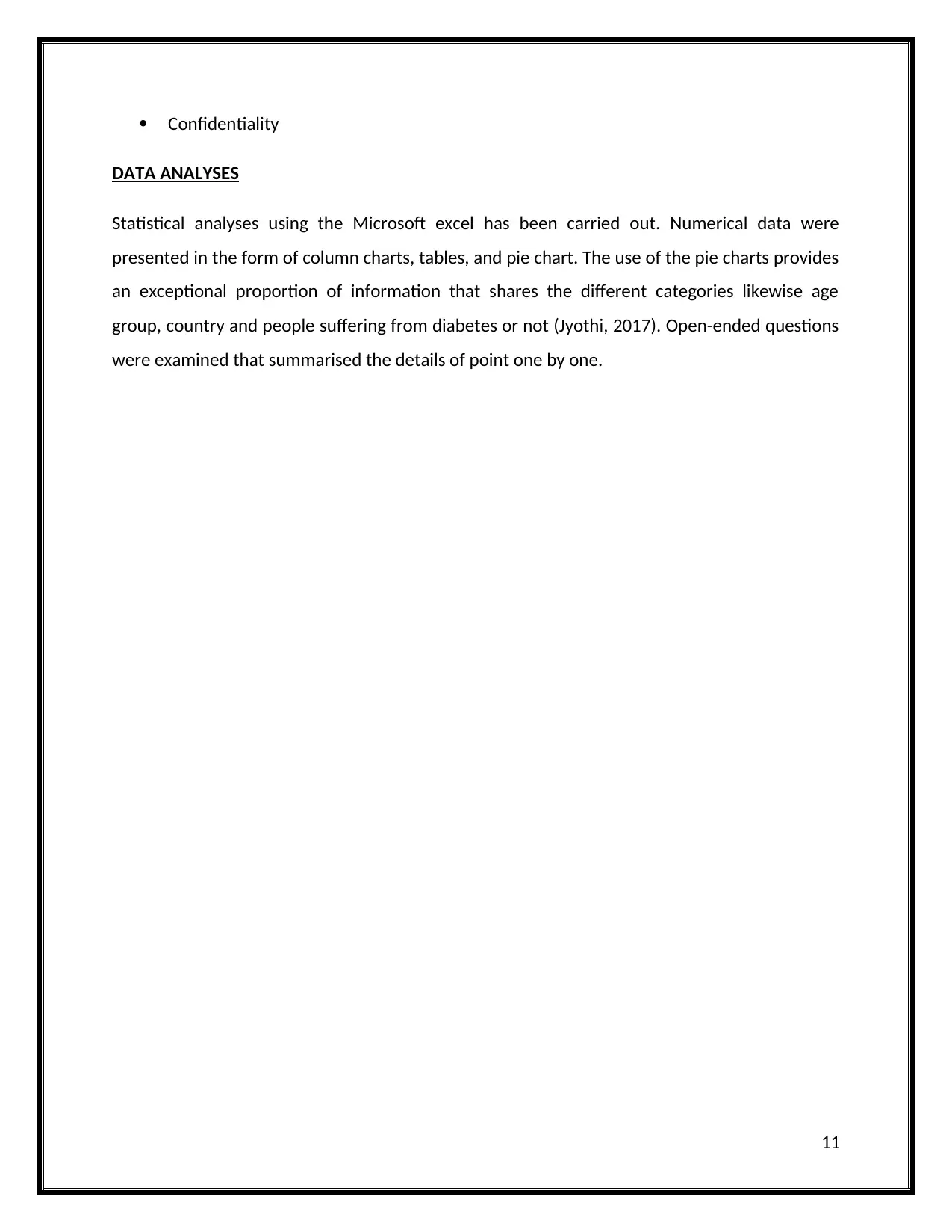
Confidentiality
DATA ANALYSES
Statistical analyses using the Microsoft excel has been carried out. Numerical data were
presented in the form of column charts, tables, and pie chart. The use of the pie charts provides
an exceptional proportion of information that shares the different categories likewise age
group, country and people suffering from diabetes or not (Jyothi, 2017). Open-ended questions
were examined that summarised the details of point one by one.
11
DATA ANALYSES
Statistical analyses using the Microsoft excel has been carried out. Numerical data were
presented in the form of column charts, tables, and pie chart. The use of the pie charts provides
an exceptional proportion of information that shares the different categories likewise age
group, country and people suffering from diabetes or not (Jyothi, 2017). Open-ended questions
were examined that summarised the details of point one by one.
11
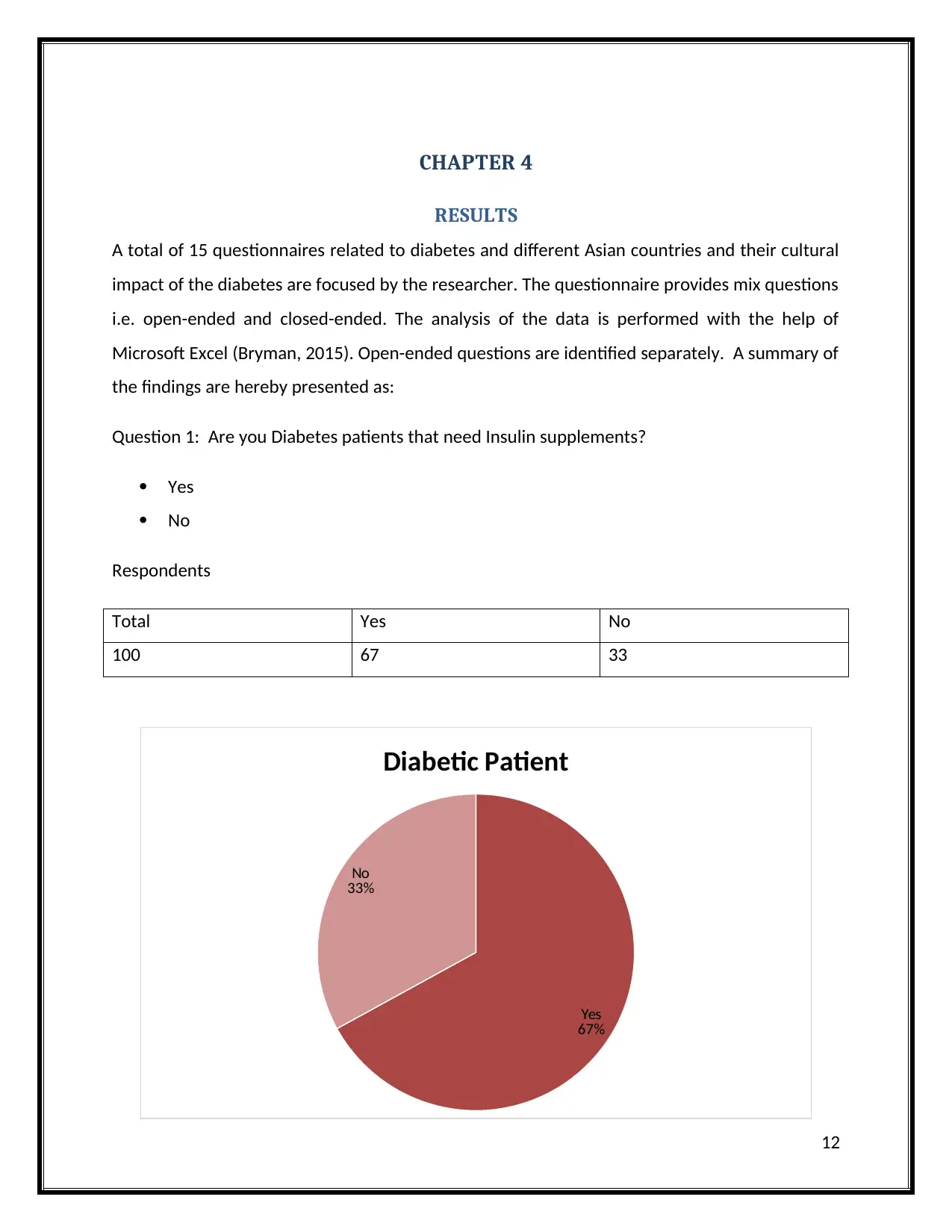
CHAPTER 4
RESULTS
A total of 15 questionnaires related to diabetes and different Asian countries and their cultural
impact of the diabetes are focused by the researcher. The questionnaire provides mix questions
i.e. open-ended and closed-ended. The analysis of the data is performed with the help of
Microsoft Excel (Bryman, 2015). Open-ended questions are identified separately. A summary of
the findings are hereby presented as:
Question 1: Are you Diabetes patients that need Insulin supplements?
Yes
No
Respondents
Total Yes No
100 67 33
Yes
67%
No
33%
Diabetic Patient
12
RESULTS
A total of 15 questionnaires related to diabetes and different Asian countries and their cultural
impact of the diabetes are focused by the researcher. The questionnaire provides mix questions
i.e. open-ended and closed-ended. The analysis of the data is performed with the help of
Microsoft Excel (Bryman, 2015). Open-ended questions are identified separately. A summary of
the findings are hereby presented as:
Question 1: Are you Diabetes patients that need Insulin supplements?
Yes
No
Respondents
Total Yes No
100 67 33
Yes
67%
No
33%
Diabetic Patient
12
Secure Best Marks with AI Grader
Need help grading? Try our AI Grader for instant feedback on your assignments.
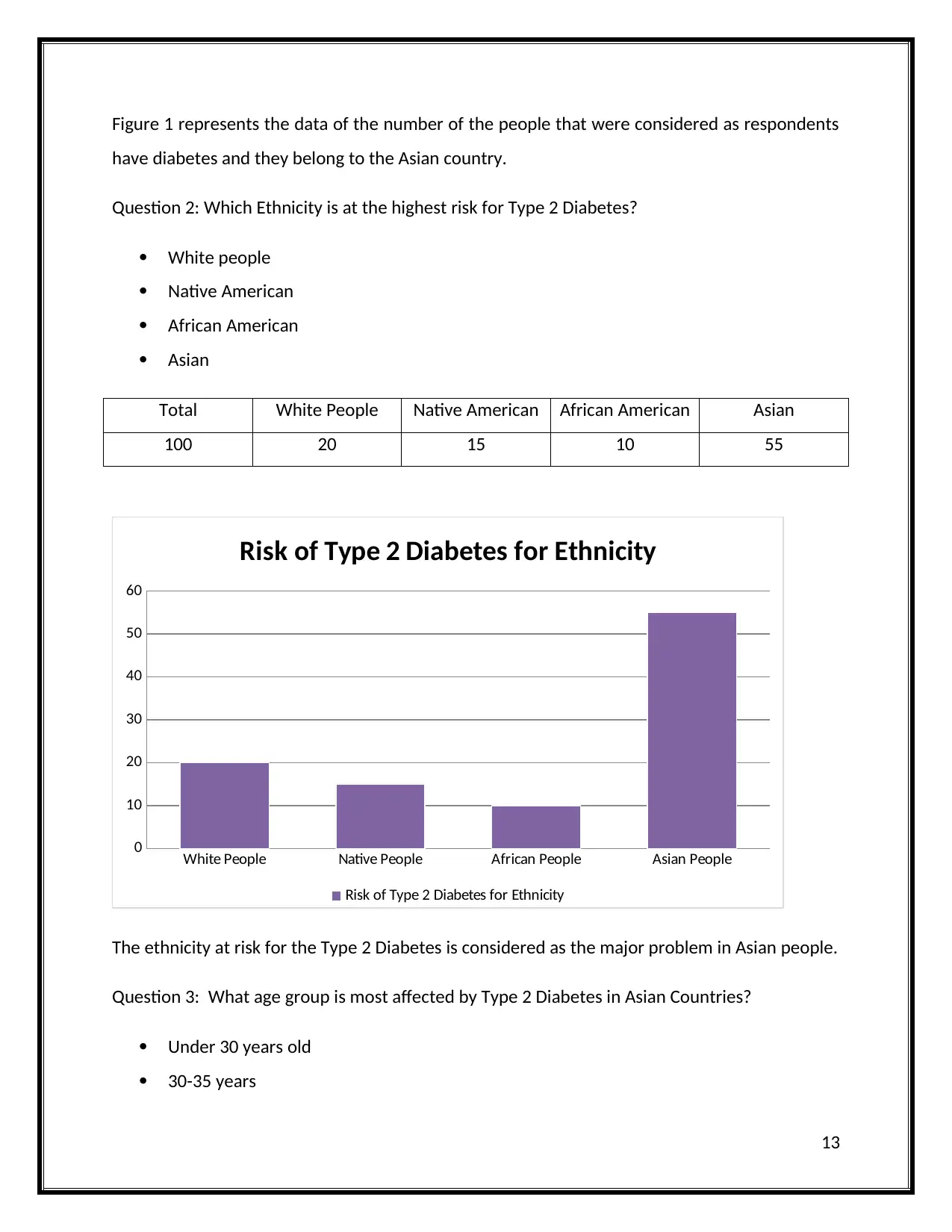
Figure 1 represents the data of the number of the people that were considered as respondents
have diabetes and they belong to the Asian country.
Question 2: Which Ethnicity is at the highest risk for Type 2 Diabetes?
White people
Native American
African American
Asian
Total White People Native American African American Asian
100 20 15 10 55
White People Native People African People Asian People
0
10
20
30
40
50
60
Risk of Type 2 Diabetes for Ethnicity
Risk of Type 2 Diabetes for Ethnicity
The ethnicity at risk for the Type 2 Diabetes is considered as the major problem in Asian people.
Question 3: What age group is most affected by Type 2 Diabetes in Asian Countries?
Under 30 years old
30-35 years
13
have diabetes and they belong to the Asian country.
Question 2: Which Ethnicity is at the highest risk for Type 2 Diabetes?
White people
Native American
African American
Asian
Total White People Native American African American Asian
100 20 15 10 55
White People Native People African People Asian People
0
10
20
30
40
50
60
Risk of Type 2 Diabetes for Ethnicity
Risk of Type 2 Diabetes for Ethnicity
The ethnicity at risk for the Type 2 Diabetes is considered as the major problem in Asian people.
Question 3: What age group is most affected by Type 2 Diabetes in Asian Countries?
Under 30 years old
30-35 years
13
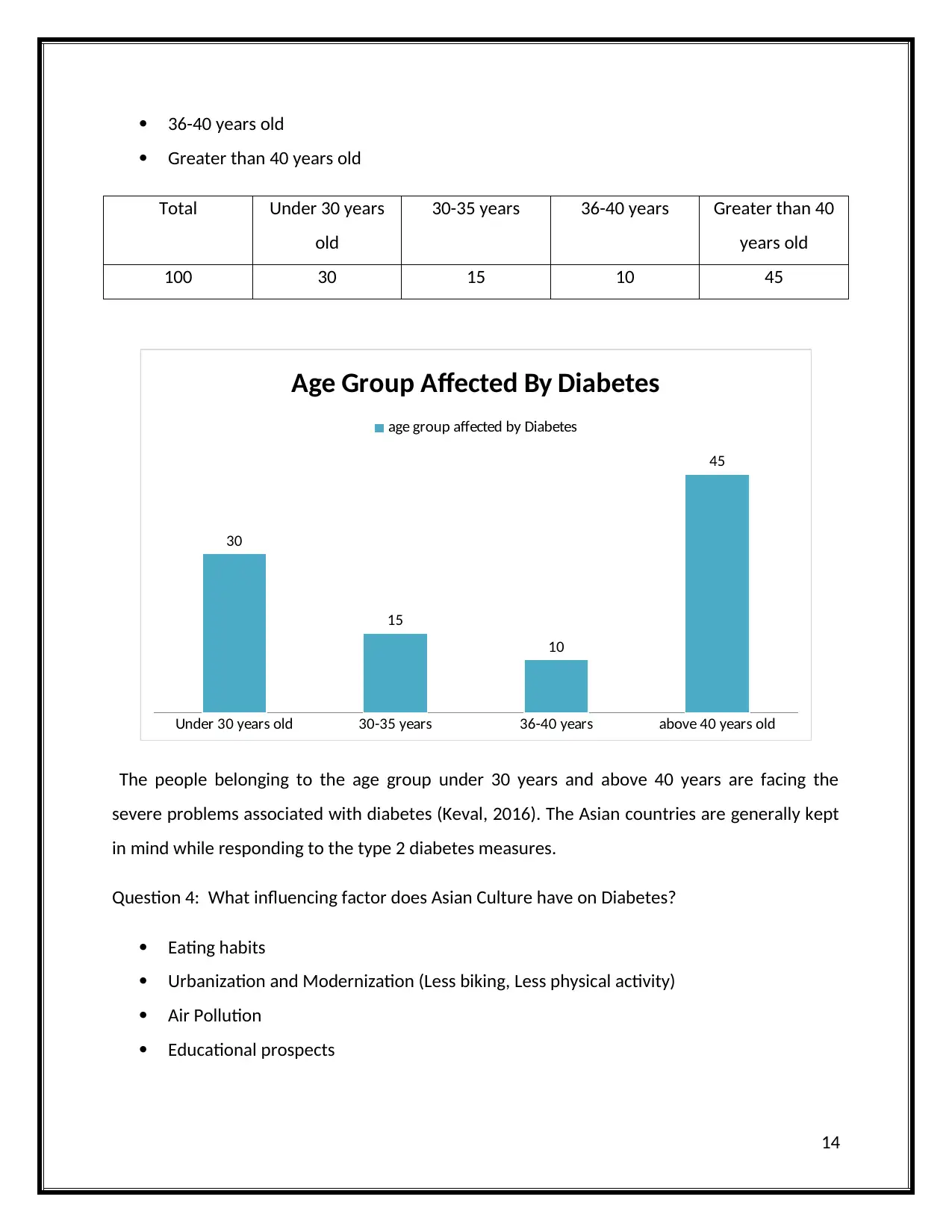
36-40 years old
Greater than 40 years old
Total Under 30 years
old
30-35 years 36-40 years Greater than 40
years old
100 30 15 10 45
Under 30 years old 30-35 years 36-40 years above 40 years old
30
15
10
45
Age Group Affected By Diabetes
age group affected by Diabetes
The people belonging to the age group under 30 years and above 40 years are facing the
severe problems associated with diabetes (Keval, 2016). The Asian countries are generally kept
in mind while responding to the type 2 diabetes measures.
Question 4: What influencing factor does Asian Culture have on Diabetes?
Eating habits
Urbanization and Modernization (Less biking, Less physical activity)
Air Pollution
Educational prospects
14
Greater than 40 years old
Total Under 30 years
old
30-35 years 36-40 years Greater than 40
years old
100 30 15 10 45
Under 30 years old 30-35 years 36-40 years above 40 years old
30
15
10
45
Age Group Affected By Diabetes
age group affected by Diabetes
The people belonging to the age group under 30 years and above 40 years are facing the
severe problems associated with diabetes (Keval, 2016). The Asian countries are generally kept
in mind while responding to the type 2 diabetes measures.
Question 4: What influencing factor does Asian Culture have on Diabetes?
Eating habits
Urbanization and Modernization (Less biking, Less physical activity)
Air Pollution
Educational prospects
14

Total Eating habits Urbanization and
Modernization
Air Pollution Educational
Prospects
100 37 24 13 26
Eating Habits Urbanization
and
Modernization
Air Pollution Educational
Prospect
0
5
10
15
20
25
30
35
40
FACTORS IMPACTING ASIAN
CULTURE HAVE ON DIABETES
Factors influence on Diabetes assessing to Asian Culture
The figure provides the information that a number of the respondents faces Diabetes problem
in Asian countries is due to their eating habits (37%) and education prospects (26%). Later
comes, Urbanization and Modernization (24%) along with air pollution (13%).
Question 5: Insulin Injections can be used for the treatment of Diabetes in Asian Countries?
True
False
15
Modernization
Air Pollution Educational
Prospects
100 37 24 13 26
Eating Habits Urbanization
and
Modernization
Air Pollution Educational
Prospect
0
5
10
15
20
25
30
35
40
FACTORS IMPACTING ASIAN
CULTURE HAVE ON DIABETES
Factors influence on Diabetes assessing to Asian Culture
The figure provides the information that a number of the respondents faces Diabetes problem
in Asian countries is due to their eating habits (37%) and education prospects (26%). Later
comes, Urbanization and Modernization (24%) along with air pollution (13%).
Question 5: Insulin Injections can be used for the treatment of Diabetes in Asian Countries?
True
False
15
Paraphrase This Document
Need a fresh take? Get an instant paraphrase of this document with our AI Paraphraser
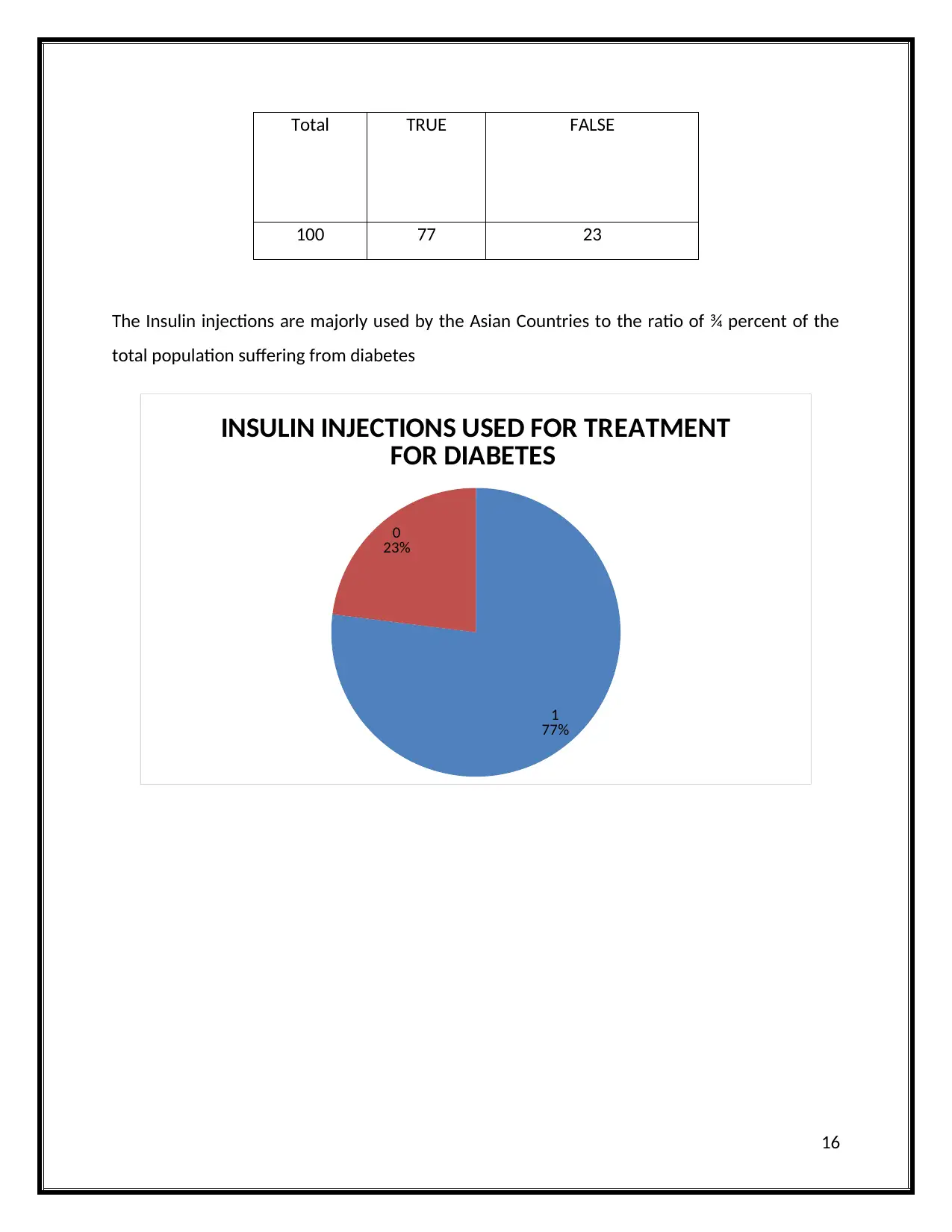
Total TRUE FALSE
100 77 23
The Insulin injections are majorly used by the Asian Countries to the ratio of ¾ percent of the
total population suffering from diabetes
1
77%
0
23%
INSULIN INJECTIONS USED FOR TREATMENT
FOR DIABETES
16
100 77 23
The Insulin injections are majorly used by the Asian Countries to the ratio of ¾ percent of the
total population suffering from diabetes
1
77%
0
23%
INSULIN INJECTIONS USED FOR TREATMENT
FOR DIABETES
16

CHAPTER 4
DISCUSSION
The study aims to provide the information on the Asian Countries Cultural practices that impact
on the disease like Diabetes. The objectives discovering the areas assessed in further
development in curing the disease. The objective is to determine the factors that are
responsible for influence cultural practices of the Asian countries on disease like diabetes.
Different measures were assessed such as Insulin Injections, Physical activities practices,
drinking wine and other measures (Ramachandran, et al. 2010). The findings were able to
answer the research question that was the objective.
In the study the majority of the participants were belonging to the age group 30- 40 years as
the comparatively high measures are found in them. Thus, in order to carry out the research, it
is necessary to focus on the Asian culture which mainly relies on the diabetes problems due to
their eating habits, poor nutrition (BMI) index and urbanization and modernization even
educational prospects.
It has been observed on the basis of a factor that 37% of the Asian population suffers from
diabetes due to eating habits and 26% due to educational prospects (Chakraborty and Das,
2016). In this study, the majority of the people belongs to India, China, Bangladesh and
Malaysia as the diabetes diseases are found at a greater peak in those countries. Concerning
factor that prevents students from eating healthy i.e. less fatty food are due to their cultural
habits. A strong prevalence to the mentality of the Asian Culture can be addressed to be the
reason of increasing rate of diabetes in the people and is being found in the people belonging
to age group less than 25-30 years (Vlaar, et al. 2017).
The study also provides the prevention measures that can be adopted in order to overcome
those health problems are control the weight through excessing healthy diet plan and physical
activities, skipping the sugary drinks and rely on water, coffee or tea instead. Include good fats,
limit the red meat and choose nuts, fish, and grains or poultry products instead. Try to quit
17
DISCUSSION
The study aims to provide the information on the Asian Countries Cultural practices that impact
on the disease like Diabetes. The objectives discovering the areas assessed in further
development in curing the disease. The objective is to determine the factors that are
responsible for influence cultural practices of the Asian countries on disease like diabetes.
Different measures were assessed such as Insulin Injections, Physical activities practices,
drinking wine and other measures (Ramachandran, et al. 2010). The findings were able to
answer the research question that was the objective.
In the study the majority of the participants were belonging to the age group 30- 40 years as
the comparatively high measures are found in them. Thus, in order to carry out the research, it
is necessary to focus on the Asian culture which mainly relies on the diabetes problems due to
their eating habits, poor nutrition (BMI) index and urbanization and modernization even
educational prospects.
It has been observed on the basis of a factor that 37% of the Asian population suffers from
diabetes due to eating habits and 26% due to educational prospects (Chakraborty and Das,
2016). In this study, the majority of the people belongs to India, China, Bangladesh and
Malaysia as the diabetes diseases are found at a greater peak in those countries. Concerning
factor that prevents students from eating healthy i.e. less fatty food are due to their cultural
habits. A strong prevalence to the mentality of the Asian Culture can be addressed to be the
reason of increasing rate of diabetes in the people and is being found in the people belonging
to age group less than 25-30 years (Vlaar, et al. 2017).
The study also provides the prevention measures that can be adopted in order to overcome
those health problems are control the weight through excessing healthy diet plan and physical
activities, skipping the sugary drinks and rely on water, coffee or tea instead. Include good fats,
limit the red meat and choose nuts, fish, and grains or poultry products instead. Try to quit
17
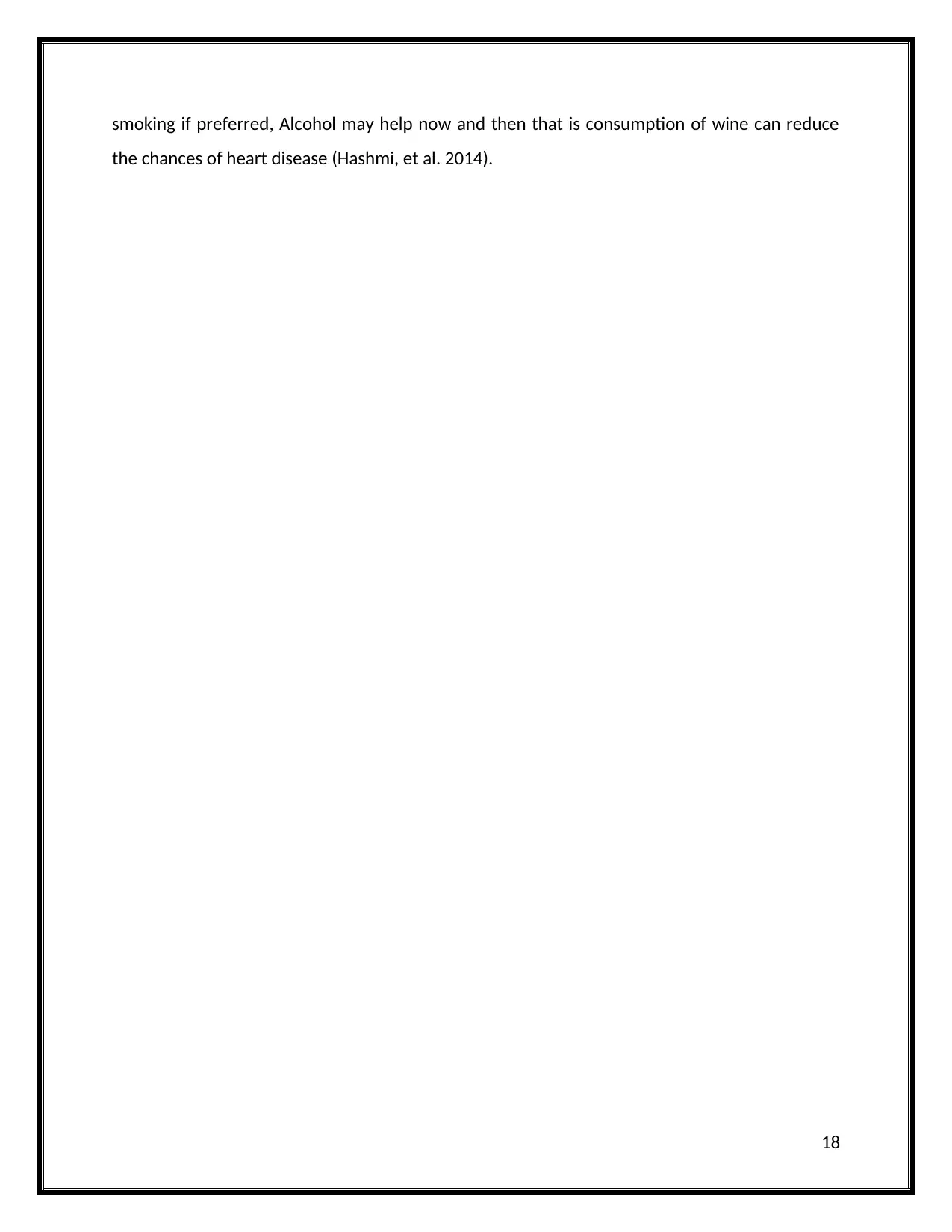
smoking if preferred, Alcohol may help now and then that is consumption of wine can reduce
the chances of heart disease (Hashmi, et al. 2014).
18
the chances of heart disease (Hashmi, et al. 2014).
18
Secure Best Marks with AI Grader
Need help grading? Try our AI Grader for instant feedback on your assignments.
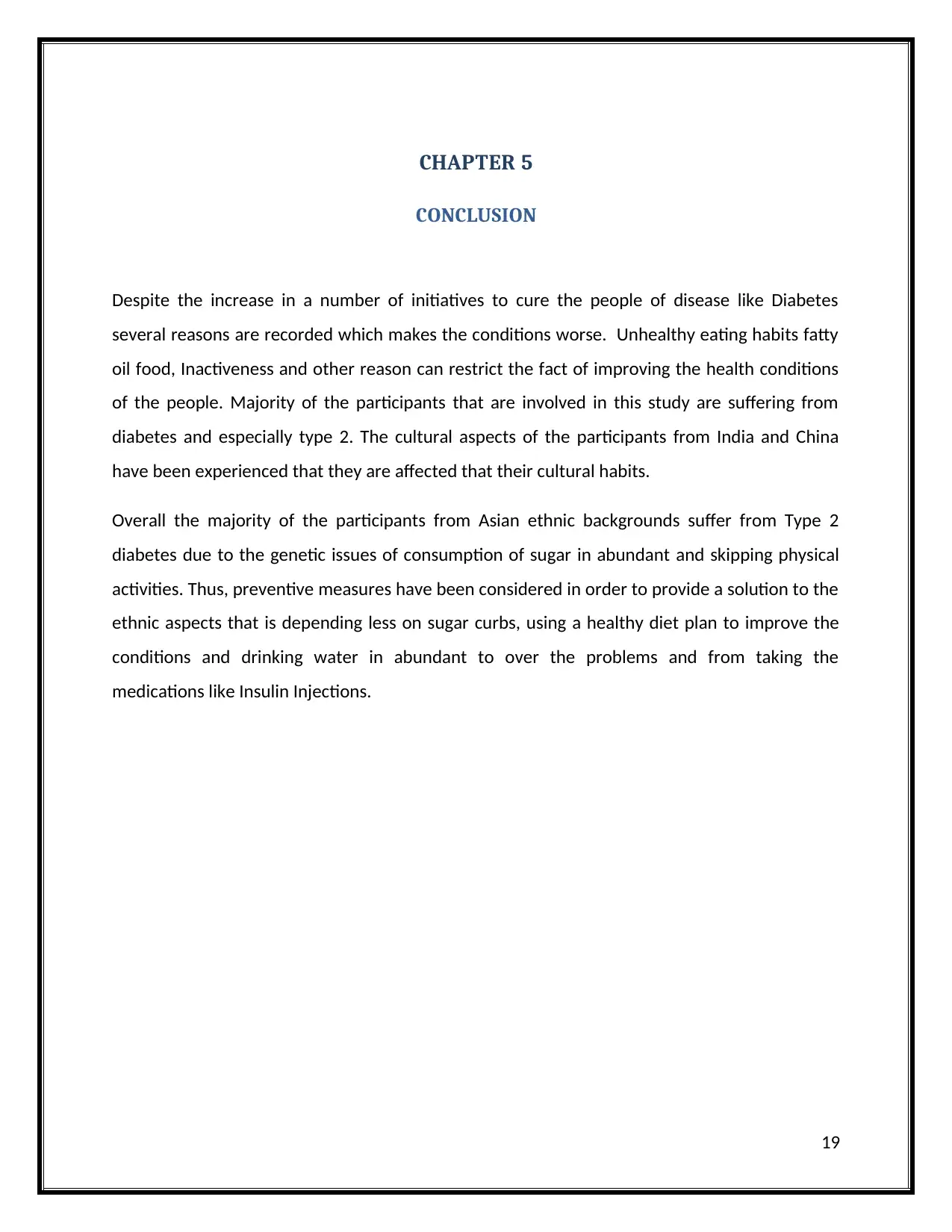
CHAPTER 5
CONCLUSION
Despite the increase in a number of initiatives to cure the people of disease like Diabetes
several reasons are recorded which makes the conditions worse. Unhealthy eating habits fatty
oil food, Inactiveness and other reason can restrict the fact of improving the health conditions
of the people. Majority of the participants that are involved in this study are suffering from
diabetes and especially type 2. The cultural aspects of the participants from India and China
have been experienced that they are affected that their cultural habits.
Overall the majority of the participants from Asian ethnic backgrounds suffer from Type 2
diabetes due to the genetic issues of consumption of sugar in abundant and skipping physical
activities. Thus, preventive measures have been considered in order to provide a solution to the
ethnic aspects that is depending less on sugar curbs, using a healthy diet plan to improve the
conditions and drinking water in abundant to over the problems and from taking the
medications like Insulin Injections.
19
CONCLUSION
Despite the increase in a number of initiatives to cure the people of disease like Diabetes
several reasons are recorded which makes the conditions worse. Unhealthy eating habits fatty
oil food, Inactiveness and other reason can restrict the fact of improving the health conditions
of the people. Majority of the participants that are involved in this study are suffering from
diabetes and especially type 2. The cultural aspects of the participants from India and China
have been experienced that they are affected that their cultural habits.
Overall the majority of the participants from Asian ethnic backgrounds suffer from Type 2
diabetes due to the genetic issues of consumption of sugar in abundant and skipping physical
activities. Thus, preventive measures have been considered in order to provide a solution to the
ethnic aspects that is depending less on sugar curbs, using a healthy diet plan to improve the
conditions and drinking water in abundant to over the problems and from taking the
medications like Insulin Injections.
19
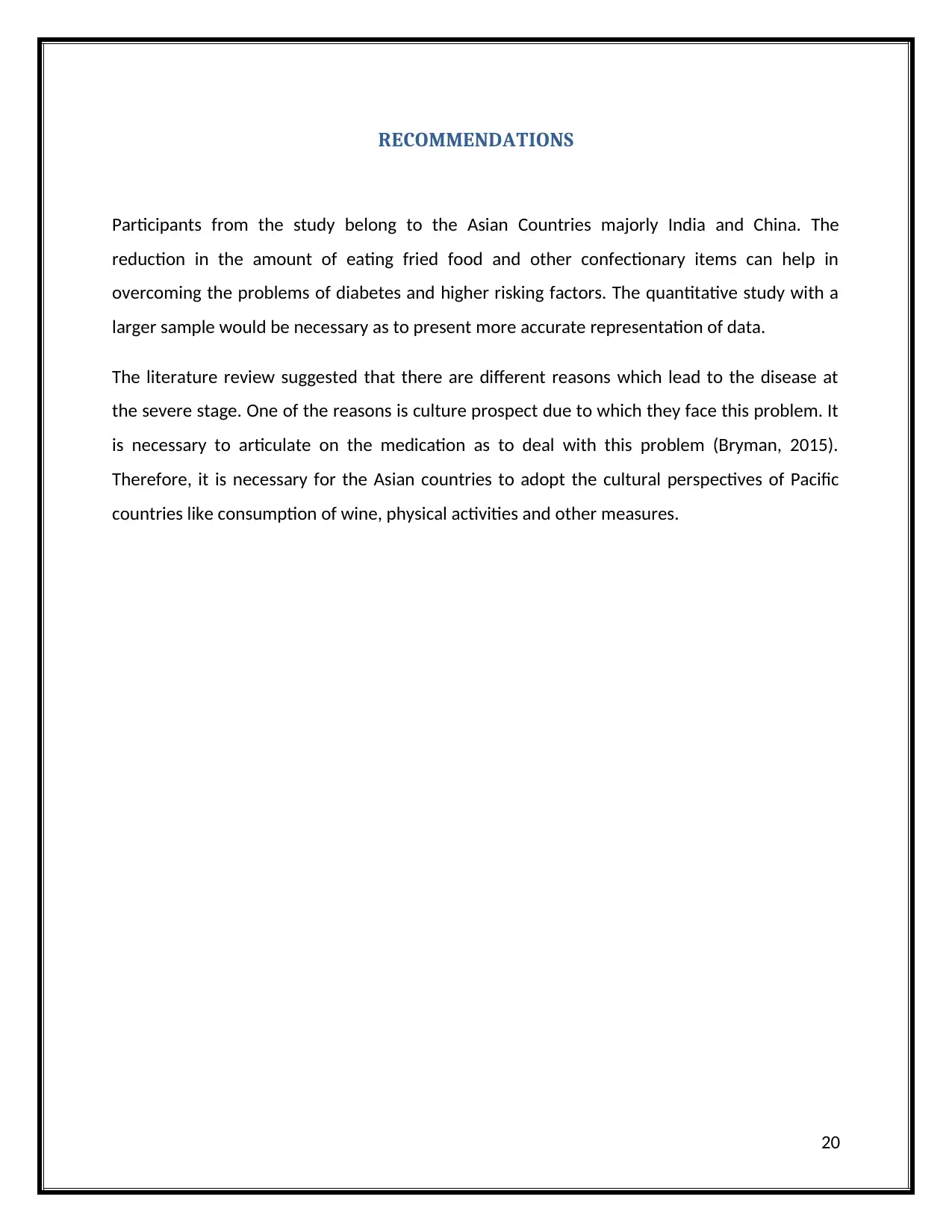
RECOMMENDATIONS
Participants from the study belong to the Asian Countries majorly India and China. The
reduction in the amount of eating fried food and other confectionary items can help in
overcoming the problems of diabetes and higher risking factors. The quantitative study with a
larger sample would be necessary as to present more accurate representation of data.
The literature review suggested that there are different reasons which lead to the disease at
the severe stage. One of the reasons is culture prospect due to which they face this problem. It
is necessary to articulate on the medication as to deal with this problem (Bryman, 2015).
Therefore, it is necessary for the Asian countries to adopt the cultural perspectives of Pacific
countries like consumption of wine, physical activities and other measures.
20
Participants from the study belong to the Asian Countries majorly India and China. The
reduction in the amount of eating fried food and other confectionary items can help in
overcoming the problems of diabetes and higher risking factors. The quantitative study with a
larger sample would be necessary as to present more accurate representation of data.
The literature review suggested that there are different reasons which lead to the disease at
the severe stage. One of the reasons is culture prospect due to which they face this problem. It
is necessary to articulate on the medication as to deal with this problem (Bryman, 2015).
Therefore, it is necessary for the Asian countries to adopt the cultural perspectives of Pacific
countries like consumption of wine, physical activities and other measures.
20

BIBLIOGRAPHY
Bryman, A., 2015. Social research methods. Oxford university press.
Chakraborty, C. and Das, S., 2016. Dynamics of diabetes and obesity: an alarming situation in
the developing countries in Asia. Mini reviews in medicinal chemistry, 16(15), pp.1258-1268.
Hashmi, A., Alazmi, F.M. and Somroo, J.A., 2014. Cultural Concepts and Behavioral Influences
on Women of South-East Asia.
Joshi, S.R. and Aravind, S.R., 2017. Diabetes in India and Southeast Asia. In Diabetes Mellitus in
Developing Countries and Underserved Communities (pp. 85-100). Springer, Cham.
Jyothi, T., 2017. EFFICACY OF DAILY ROUTINE FOR HEALTH MANAGEMENT IN MODERN
LIFESTYLE.
Kaveeshwar, S.A. and Cornwall, J., 2014. The current state of diabetes mellitus in India. The
Australasian medical journal, 7(1), p.45.
Keval, H., 2016. Conceptualising Race, Ethnicity, and Health. In Health, Ethnicity and Diabetes
(pp. 15-37). Palgrave Macmillan, London.
Ramachandran, A., Ma, R.C.W. and Snehalatha, C., 2010. Diabetes in Asia. The Lancet,
375(9712), pp.408-418.
Saddichha, S., Manjunatha, N. and Khess, C.R.J., 2010. Why do we need to control alcohol use
through legislative measures? A south east asia perspective?. Indian journal of community
medicine: official publication of Indian Association of Preventive & Social Medicine, 35(1),
p.147.
Vlaar, E.M., Nierkens, V., Nicolaou, M., Middelkoop, B.J., Busschers, W.B., Stronks, K. and van
Valkengoed, I.G., 2017. Effectiveness of a targeted lifestyle intervention in primary care on diet
and physical activity among south asians at risk for diabetes: 2-year results of a randomised
controlled trial in the netherlands. BMJ open, 7(6), p.e012221.
21
Bryman, A., 2015. Social research methods. Oxford university press.
Chakraborty, C. and Das, S., 2016. Dynamics of diabetes and obesity: an alarming situation in
the developing countries in Asia. Mini reviews in medicinal chemistry, 16(15), pp.1258-1268.
Hashmi, A., Alazmi, F.M. and Somroo, J.A., 2014. Cultural Concepts and Behavioral Influences
on Women of South-East Asia.
Joshi, S.R. and Aravind, S.R., 2017. Diabetes in India and Southeast Asia. In Diabetes Mellitus in
Developing Countries and Underserved Communities (pp. 85-100). Springer, Cham.
Jyothi, T., 2017. EFFICACY OF DAILY ROUTINE FOR HEALTH MANAGEMENT IN MODERN
LIFESTYLE.
Kaveeshwar, S.A. and Cornwall, J., 2014. The current state of diabetes mellitus in India. The
Australasian medical journal, 7(1), p.45.
Keval, H., 2016. Conceptualising Race, Ethnicity, and Health. In Health, Ethnicity and Diabetes
(pp. 15-37). Palgrave Macmillan, London.
Ramachandran, A., Ma, R.C.W. and Snehalatha, C., 2010. Diabetes in Asia. The Lancet,
375(9712), pp.408-418.
Saddichha, S., Manjunatha, N. and Khess, C.R.J., 2010. Why do we need to control alcohol use
through legislative measures? A south east asia perspective?. Indian journal of community
medicine: official publication of Indian Association of Preventive & Social Medicine, 35(1),
p.147.
Vlaar, E.M., Nierkens, V., Nicolaou, M., Middelkoop, B.J., Busschers, W.B., Stronks, K. and van
Valkengoed, I.G., 2017. Effectiveness of a targeted lifestyle intervention in primary care on diet
and physical activity among south asians at risk for diabetes: 2-year results of a randomised
controlled trial in the netherlands. BMJ open, 7(6), p.e012221.
21
Paraphrase This Document
Need a fresh take? Get an instant paraphrase of this document with our AI Paraphraser
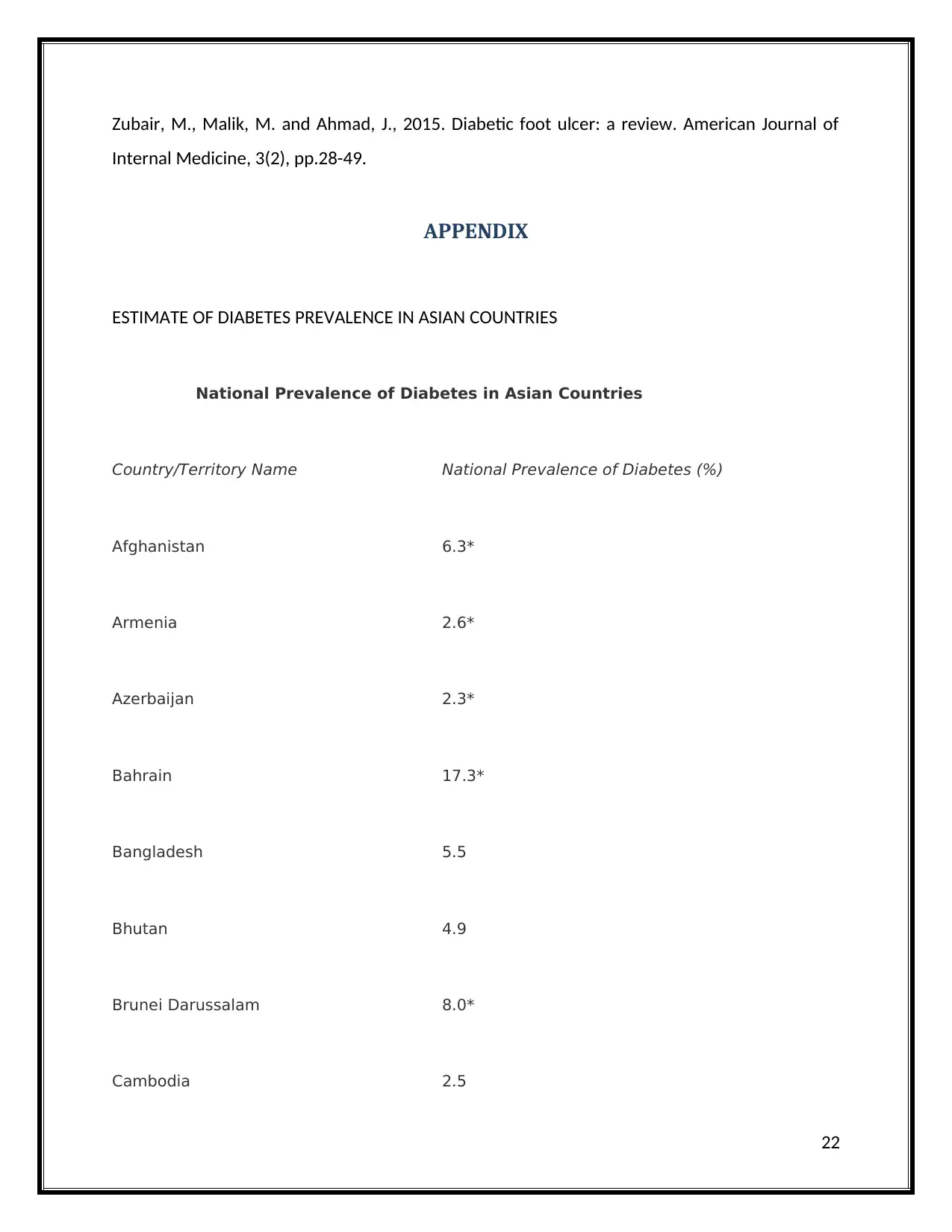
Zubair, M., Malik, M. and Ahmad, J., 2015. Diabetic foot ulcer: a review. American Journal of
Internal Medicine, 3(2), pp.28-49.
APPENDIX
ESTIMATE OF DIABETES PREVALENCE IN ASIAN COUNTRIES
National Prevalence of Diabetes in Asian Countries
Country/Territory Name National Prevalence of Diabetes (%)
Afghanistan 6.3*
Armenia 2.6*
Azerbaijan 2.3*
Bahrain 17.3*
Bangladesh 5.5
Bhutan 4.9
Brunei Darussalam 8.0*
Cambodia 2.5
22
Internal Medicine, 3(2), pp.28-49.
APPENDIX
ESTIMATE OF DIABETES PREVALENCE IN ASIAN COUNTRIES
National Prevalence of Diabetes in Asian Countries
Country/Territory Name National Prevalence of Diabetes (%)
Afghanistan 6.3*
Armenia 2.6*
Azerbaijan 2.3*
Bahrain 17.3*
Bangladesh 5.5
Bhutan 4.9
Brunei Darussalam 8.0*
Cambodia 2.5
22

China 9.6
Cyprus 10.2
Democratic People's Republic of Korea 7.3*
Georgia 3.0*
Hong Kong SAR (China) 9.5
India 8.6
Indonesia 5.6
Iraq 7.4
Islamic Republic of Iran 8.4
Israel 6.7
Japan 7.6
Jordan 8.7
Kazakhstan 4.9*
23
Cyprus 10.2
Democratic People's Republic of Korea 7.3*
Georgia 3.0*
Hong Kong SAR (China) 9.5
India 8.6
Indonesia 5.6
Iraq 7.4
Islamic Republic of Iran 8.4
Israel 6.7
Japan 7.6
Jordan 8.7
Kazakhstan 4.9*
23

Kuwait 17.8
Kyrgyzstan 5.0*
Lao People's Democratic Republic 4.4*
Lebanon 14.5
Macau SAR (China) 9.5*
Malaysia 10.1
Maldives 3.8*
Mongolia 7.5
Myanmar 5.7
Nepal 4.5
Oman 8.0
Pakistan 6.8
Philippines 6.0
24
Kyrgyzstan 5.0*
Lao People's Democratic Republic 4.4*
Lebanon 14.5
Macau SAR (China) 9.5*
Malaysia 10.1
Maldives 3.8*
Mongolia 7.5
Myanmar 5.7
Nepal 4.5
Oman 8.0
Pakistan 6.8
Philippines 6.0
24
Secure Best Marks with AI Grader
Need help grading? Try our AI Grader for instant feedback on your assignments.
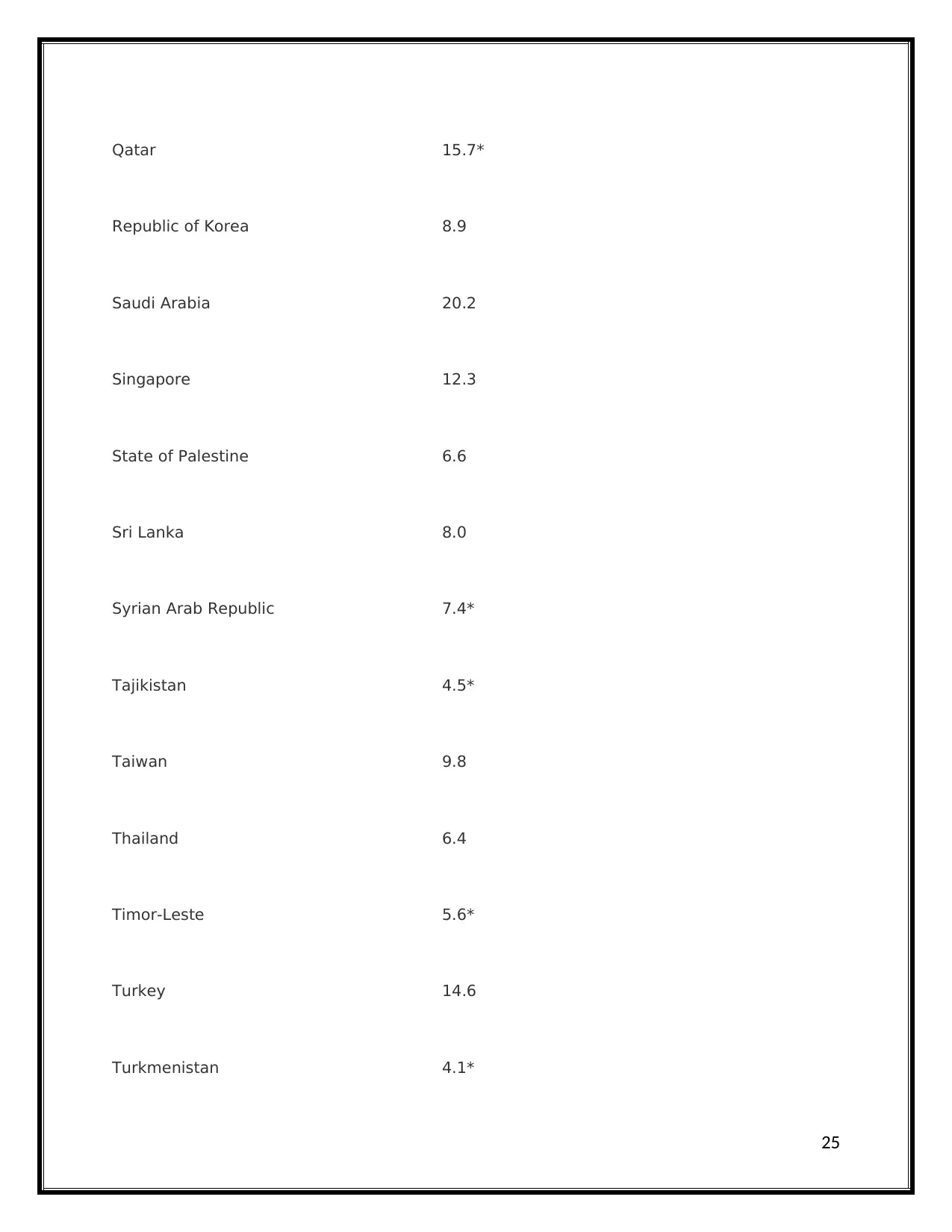
Qatar 15.7*
Republic of Korea 8.9
Saudi Arabia 20.2
Singapore 12.3
State of Palestine 6.6
Sri Lanka 8.0
Syrian Arab Republic 7.4*
Tajikistan 4.5*
Taiwan 9.8
Thailand 6.4
Timor-Leste 5.6*
Turkey 14.6
Turkmenistan 4.1*
25
Republic of Korea 8.9
Saudi Arabia 20.2
Singapore 12.3
State of Palestine 6.6
Sri Lanka 8.0
Syrian Arab Republic 7.4*
Tajikistan 4.5*
Taiwan 9.8
Thailand 6.4
Timor-Leste 5.6*
Turkey 14.6
Turkmenistan 4.1*
25
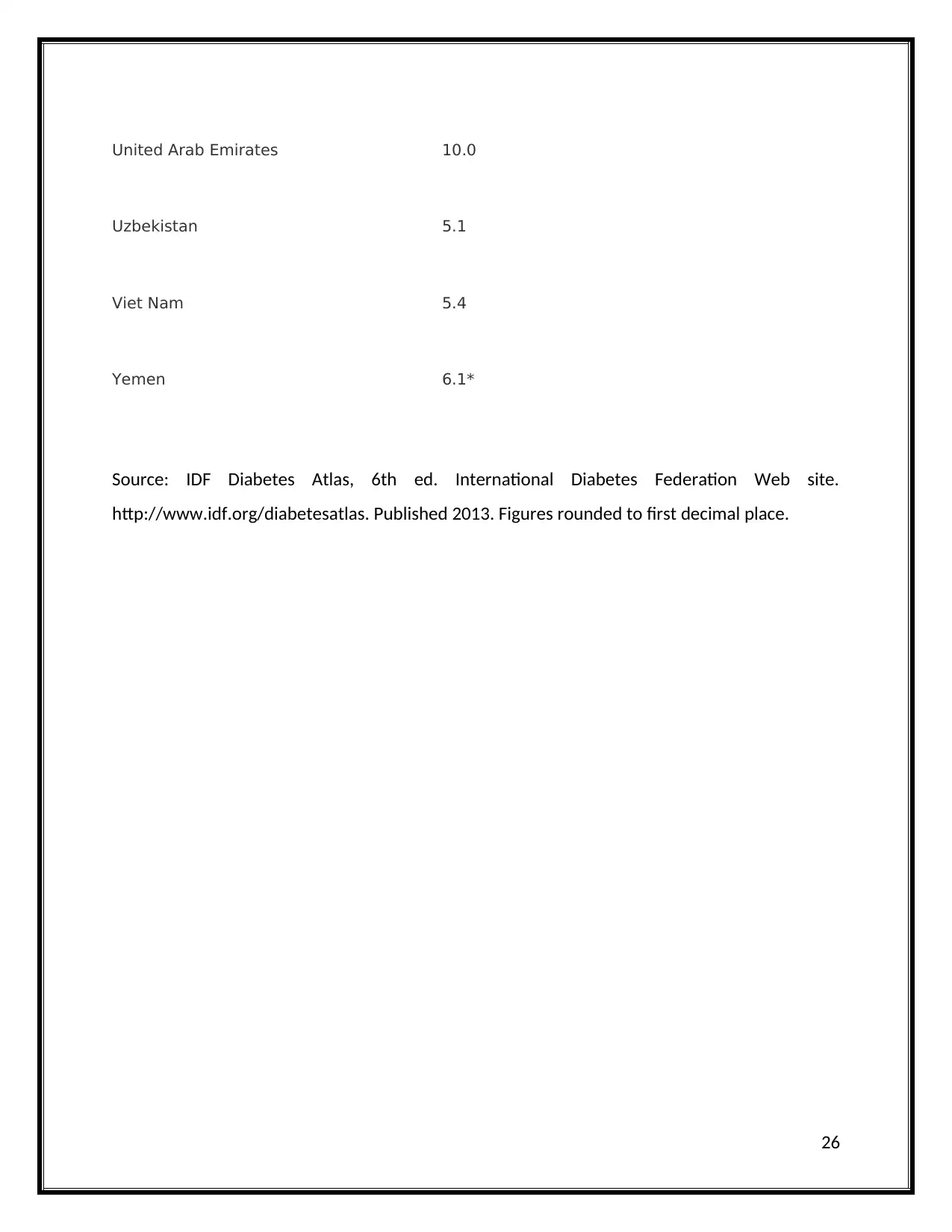
United Arab Emirates 10.0
Uzbekistan 5.1
Viet Nam 5.4
Yemen 6.1*
Source: IDF Diabetes Atlas, 6th ed. International Diabetes Federation Web site.
http://www.idf.org/diabetesatlas. Published 2013. Figures rounded to first decimal place.
26
Uzbekistan 5.1
Viet Nam 5.4
Yemen 6.1*
Source: IDF Diabetes Atlas, 6th ed. International Diabetes Federation Web site.
http://www.idf.org/diabetesatlas. Published 2013. Figures rounded to first decimal place.
26

27
1 out of 28
Related Documents
Your All-in-One AI-Powered Toolkit for Academic Success.
+13062052269
info@desklib.com
Available 24*7 on WhatsApp / Email
![[object Object]](/_next/static/media/star-bottom.7253800d.svg)
Unlock your academic potential
© 2024 | Zucol Services PVT LTD | All rights reserved.





